|
We are pleased to present the first in our
series of
ONLINE SELLING EXHIBITIONS
The first in our series of exhibitions is
ARTS & CRAFTS BOOKS and BOOK DESIGN
Featuring books, magazines, journals, art-work,
and much more!
This exhibition is due to help, guidance and
assistance of Larisa Cassell. We can provide further information
and images upon request.

BOOK EXHIBITION
Prices in US Dollars, please use our
currency
converter for other currencies.
1. (Architecture and Design). GLASS PAINTS,
VARNISHES AND BRUSHES. Pittsburgh: Pittsburgh Plate Glass,
1923. First Edition. Quarto. Decorative Cloth. An outstanding
trade catalogue, 178pp; plus xxii pp. categorized index. The
date is deceptively late. The book contains a wealth of extremely
useful information for anyone interested in the restoration
or construction of the Arts and Crafts period and its transition
to Art Deco. Dozens of full page color plates, including a
large array of color samples that are an invaluable tool in
the selection of appropriate color schemes for achieving historical
accuracy in construction or renovation. In addition to color
samples and rating of paint durability, this handsome volume
addresses both commercial and residential uses of plate and
leaded glass. A very good copy with only minor edge wear and
a small paper scrape on one page. A worthy addition to the
reference library of architects, designers, contractors and
individual homeowners interested in the American Arts and
Crafts movement and its long-reaching effects on building
design. $200.00
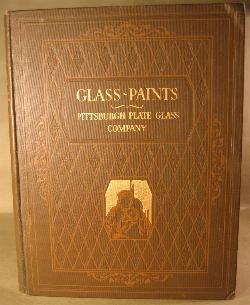
2. (Architecture and Design). BUILDER'S WOODWORK. Universal
Design Book Number 25. American Sash and Door Co. Kansas City,
Mo. Kansas City, Mo.: American Sash & Door Company, 1927.
Quarto. Published by The Universal Catalog Bureau in Dubuque,
Iowa, this catalog was available to trades people of the day
and would be printed with each company's name on the cover
and title page. Bound in original brown cloth, 356 pages,
including index. Profusely illustrated with black and white,
half tone and color illustrations of Arts and Crafts bungalow
interior and exterior elements, as well as more traditional
styles. This exceptional trade catalogue of period detail
provides invaluable assistance for interior design professionals
and home restoration. The Universal Design Book, No. 25, with
its wide array of quality materials for home construction
was distributed by various lumber and building companies,
the binding stamped with the company's name and logo. These
fine products that were the "standard choices" of
the day reveal the woeful group of look alikes offered at
modern DIY stores as the pathetic elements that they are,
both aesthetically and with regard to the quality of construction.
Although the date of the book is a bit past the generally
accepted boundaries of the Arts and Crafts period, "
Mission Style" is on abundant display in inglenooks,
bookcases, china closets, doors, stairways and more. Sun porches
with rustic furnishings are pictured and the garden is considered
with illustrations of trellises and seating. Aside from a
whisper of rubbing to the extremities, this is a flawless
copy. $350.00

3. (Architecture). THE COUNTRY HOME. Volume I. May
to October. London: Archibald Constable & Company, Ltd.,
1908. A quarto of 380 pages, profusely illustrated with photographic
images as well as line drawings and half-tones This gorgeous
volume from the Arts and Crafts period of design is bound
in emerald green cloth with a pictorial cover vignette of
a fine country home drawn in black line silhouette against
a yellow twilight sky. All of the elements so prized in country
homes of the period are captured in this cover vignette....with
a neatly trimmed shrub surrounding the house, broken by two
gates and the limb of a fine old tree in the foreground. A
rose tree is staked outside the border of the scene. The design
is signed with the monogram of the artist, BR, in the lower
right hand corner. Gilt titles on cover and spine, top edge
gilt. Although this is only one volume of two for 1908, it
is quite complete in itself with wonderful articles and editorials
on country life, including gardening and interior and exterior
architectural designs. There are several faint spots on the
cover, else this a fine copy of a sumptuously bound Arts and
Crafts periodical of rural English life. $150.00
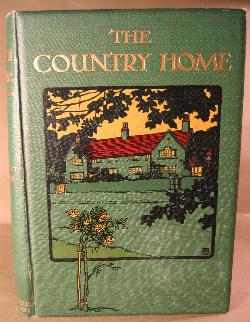
4. (Art Nouveau Book Design) Pink, Alfred. GARDEN FOR THE
MILLION. London (1904): T. Fisher Unwin, An octavo of
267 pages bound in the original pictorial cloth of a gardener
in a white shirt and hat tending a garden bed with his rake.
The spine features a large bay standard with twisted twin
trunks set in a large pot. This exceptional publisher's trade
binding is executed in white, olive and chartreuse green set
against navy blue. Colored frontispiece of sweet peas. Written
by the author of Recipe For The Million, it contains a wealth
of practical information for garden lovers. The text can be
readily had in various internet formats and reproductions.....but
the satisfaction of the boldly handsome binding, representing
the best elements of the Arts and Crafts period of design,
cannot be captured in modern commercial endeavors. A bit of
light foxing and rubbing as well as a little wear to the spine
extremities. Overall a very good copy indeed of this scarce
title in its original binding. $175.00
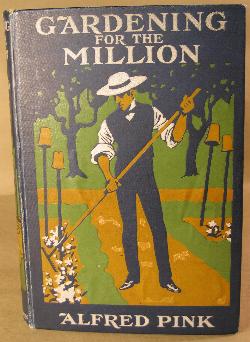
5. (Art Nouveau Trade Binding)(Turbayne, A. A.) Peacock, Thomas
Love. HEADLONG HALL and NIGHTMARE ABBEY. London &
New York: Macmillan and Co., 1896. Octavo, 244 pages bound
in original dark blue cloth. Illustrated by H. R. Millar.
A smashing copy of a stunning Art Nouveau trade binding featuring
A. A. Turbayne's gilt peacock design on the upper cover and
spine. All edges gilt. Turbayne was one of the leading book
designers at the Carlton Studio, responsible for some of the
most notable trade bindings of the period, of which this is
certainly one. The peacock motif, a favorite of the Art Nouveau
period, is repeated in yellow on the endleaves. There is a
large gift label on the front pastedown offering Holiday greetings
from the firm of Greenlees & Sons. 1918 - 19. The label
faces a presentation inscription to Beatrice Alice Hill, January
1919. Greenlees & Sons were one of the largest boot and
shoemaking firms in Britain at the turn of the last century.
Their shop windows adorned fashionable streets from London
to the Scottish Highlands, including one located at 17 High
Street, Inverness. A pristine copy, as fine and bright as
the day it was published, with an interesting British association.
$150.00
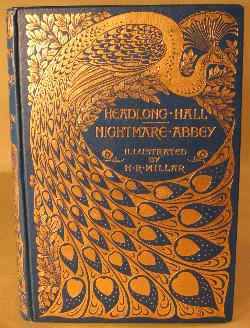
6.) (Architecture & Design). LOW COST
HOMES. (Circa 1930): The Houston Doughty Lumber Co., Pictorial
wrappers. Illustrated in color and black and white, this trade
catalog features modest homes based primarily on bungalow
and cottage design. Thumbnail plans for interiors and dimensions
with each home. Light soil to front cover, else a very good
copy. $50.00
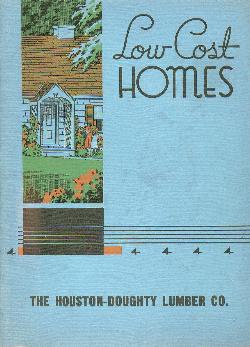
7.) (Arts and Crafts Design). RADFORD'S ARTISTIC BUNGALOWS.
Unique Collection of 208 Designs. Chicago and New York, (1908).
The Radford Architectural Company, First edition, quarto,
219 pages + index and ads. A collection of 208 designs for
smaller homes. Includes perspective views and floor plans
with plan costs and estimated building costs. The cover has
some soiling....nevertheless, a nice copy of one of the classic
Radford titles in the original binding. These books are excellent
examples of the Arts and Crafts period...a handsome aesthetic
asset to homes exhibiting the architectural elements of cottages,
bungalows and prairie style details and a useful reference
for design professionals. $250.00
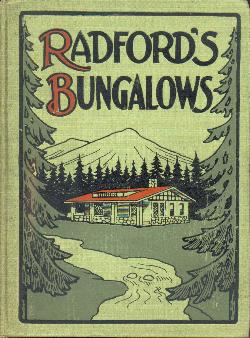
8.) (Arts and Crafts Design) (Chicago Interest) Heberling,
W. A. BASIC LETTERING Composition * Color Harmony*
Gilding* Embossing Processes, Etc. Chicago (1922): Walbrunn,
Kling & Co., Trade Catalogs, Posters, Advertising. Oblong
4to. bound in original tan cloth with exceptional Arts and
Crafts cover design executed in primary green, yellow and
red. A stunning copy of this rare design book, containing
64 full page plates and 110 pages of text. Heberling was the
head of the graphic arts department at the Mooseheart Vocational
Training School. The book is considered one of the best books
of the period for preparing students interested in the graphic
arts of posters, signs and other forms of advertising. Scarce
in any condition and virtually impossible to locate in the
state of remarkable preservation of this copy of the First
Edition. $450.00

9.) (Arts and Crafts Design) Jones, Newton. NEWLY FEATHERED
MOTHER GOOSE. Philadelphia (1915): National Publishing
Company, Slim octavo bound in original pictorial boards. An
uncommon title and very scarce indeed in this condition. Originally
published in 1903, this is a fine copy of the second printing
of this charming rendition of classic Mother Goose tales.
$75.00
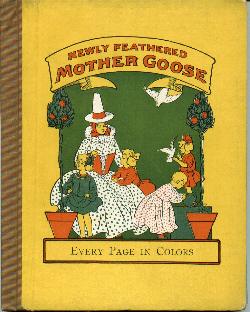
10.) (Arts and Crafts Design) Stickley, L. & J. G. THE
WORK OF L. & J. G. STICKLEY. Fayetteville, New York
(1910): A square octavo, bound in original tan pictorial wrappers
with illustration on the front cover of a room furnished with
the work of the Stickley brothers. Profusely illustrated throughout
in black and white. Aside from some light chips at the extremities
this is a fine copy of an original trade catalog, as bright
and fresh as the day it was issued. $300.00
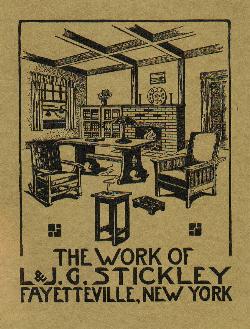
11. (Arts and Crafts Illustration). Guerber,
H. A. YOURSELF AND YOUR HOUSE WONDERFUL. Philadelphia:
The Uplift Publishing Company (1913), An octavo, 301 pages,
bound in original green cloth with color pictorial pastedown
on the front cover. This book was intended to provide guidance
for children and their parents when dealing with some of the
more sensitive issues of growing up in a respectable environment.
Parallel discussions about home and personal life abound,
accompanied by charming illustrations, some in color. No wonder
the generation of children growing up at the time the Arts
and Crafts movement began turned out to be so well-behaved.....FEAR!
A very good copy of a fascinating and attractive book. $75.00
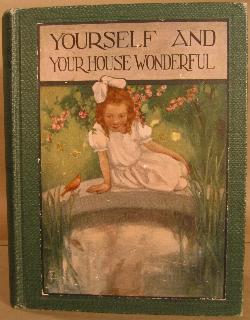
12. (Arts and Crafts). THE HOUSEKEEPER'S SCRAPBOOK.
Chicago (1911): Reilly & Britton Co., First Edition. Octavo.
Bound in original coarse tan cloth with a pictorial cover
of a woman seated at a writing table, printed in dark brown
and orange. This marvelous book has 125 pages of heavy brown
stock, each titled in dark brown, many with pictorial vignettes
illustrating the areas of a fine contemporary home, including
separate rooms, nooks, porches and gardens. The book was intended
to provide a record of home life and the pages are clean,
bright and unmarked, with the exception of erasure marks on
p. 14. Else, both contents and binding are as fresh as the
day the book was published. The furnishings, lighting fixtures
and textiles featured in the line drawings illustrate Mission
style furniture and ornamental motifs. This rare title from
one of the leading publishers of the day would be an excellent
addition to any collection representing American Arts and
Crafts style....a unique housewarming gift for Bungalow Lovers.
$250.00
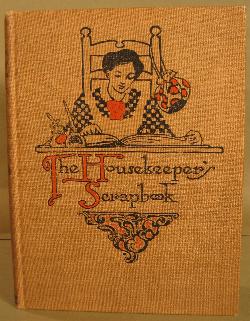
13. (Arts and Crafts). THE QUARTO AN ILLUSTRATED QUARTERLY
FOR 1896. London: J. S. Virtue, 1896. A quarto, 96 pages,
printed with lovely wide margins on heavy stock. Bound in
original olive green cloth with Art Nouveau cover design and
titles in gilt. Striking black and white illustrations by
some of the most noted artists of the day, including Alice
B. Woodward and Frederick Sandys. Articles and fiction by
G. K. Chesterton, Joseph Pennell and Gleeson White, editor
of The Studio. The Quarto was lavishly produced with only
four bound volumes published, this being the first. Aside
from some minor soil and rubbing as well as a couple of wrinkled
tissue guards, this is a fine copy of an exceptional production
representing the strong design sensibilities of the Arts and
Crafts period. $150.00
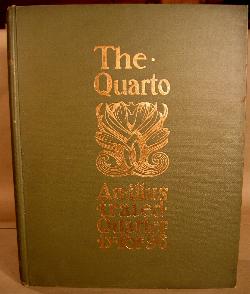
14. (Arts and Crafts). THE MENU BOOK What To Eat Today.
Chicago (1911): Reilly & Britton Co., First Edition. Octavo.
Bound in original coarse tan cloth with a pictorial cover
of a woman with a Gibson girl coif puzzling over a recipe
booklet, printed in dark brown, green and orange, including
Art Nouveau border. This handsome book has 171 pages heavy
brown stock, many with pictorial vignettes illustrating seasonal
celebrations. The illustrations and endleaves reflect the
strong influence of Arts and Crafts design and ornament. There
are several recipes hand-written in the book and some old
tape marks. The binding has one small stain on the cover...else;
this is a fine, bright copy of a rare title from one of the
leading publishers of the day. A striking addition to any
collection of books and decor relating to the golden age of
American bungalows. $175.00
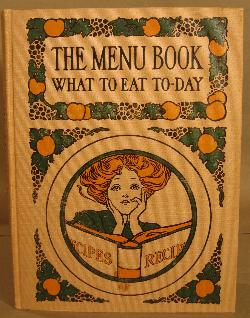
15. (Arts and Crafts). Warner, H. H. SONGS OF THE SPINDLE
& LEGENDS OF THE LOOM. London: N. J. Powell &
Co., 1889. Edition: First edition, limited to 250 numbered
copies signed by H. Selected & Arranged by H. H. Warner.
With Illustrations by A. Tucker, H. H. Warner, & Edith
Capper. H. Warner. Square octavo, unbleached coarse linen-covered
boards with ornaments and titles in black, pp. [ii], 32, illustrated,
including four Auto-Gravure plates (reproducing art work by
Arthur Tucker, H. H. Warner and Edith Capper). A collection
of spinning and weaving songs, including: "Song of the
Irish Spinning Wheel" by Alfred Perceval Graves, "Song
from Winter's Tale" by Shakespeare, and contributions
by Goldsmith, Wordsworth, Longfellow, Burns, Macaulay et al.
Also prints "The Spindle, the Shuttle, and the Needle.
A Fairy Tale" by the Brothers Grimm. Quite scarce in
any condition but particularly so with the binding so clean
and bright. Front and rear endleaves are very browned (presumably
due to binder's glue), light foxing to margins of plates,
else a near fine copy. "This little book is the product
of hand-work alone...Not only was the paper made by hand,
and the printing done by a hand-press, but the flax-which
forms the basis of both Linen and Paper-was first spun...and
the thread thus formed, was afterwards specially woven for
the cover of this book...We freely acknowledge we are in great
measure indebted to The Arts and Crafts Society..." Nicely
printed at "Beaufort House. " Limited to 250 copies,
signed by H. H. Warner. $275.00
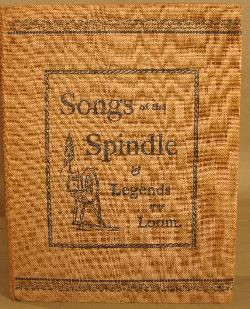
16. (Baumann, Gustave). Riley, James Whitcomb. ALL THE
YEAR ROUND. Indianapolis, (1912): The Bobbs Merrill Company,
Gustave Baumann was one of the most important woodblock artists
working in America in the twentieth century. He was born in
Germany in 1891, and moved with his family to Chicago at the
age of nine. He attended the Art Institute of Chicago and
later settled in Nashville, Indiana where he established his
own graphic arts workshop. The shop produced woodblock prints
of exceptional quality. After he had perfected the process
used in his work he relocated to Santa Fe, New Mexico and
became a leading figure in the Taos Art Colony. This book,
illustrated by Baumann in 1914 is a very desirable title to
the devotee of American Arts and Crafts style. A square quarto
bound for the Rotarians in blue cloth with gilt titling, this
is A PRISTINE COPY of the First Edition, Second Issue. Aside
from a gift inscription, dated Dec. 1916, in a graceful hand
on the front free endpaper, the book is as fine and bright
as the day it was published, retaining the original printed
dust wrapper. The dust wrapper repeats the cover design of
the book, printed in gilt and aside from a small paper scrape
and a few closed marginal tears, ( the longest measuring just
over 1") it too is very fine. The extraordinary condition
of both the book and the dust wrapper may be attributed to
the presence of the rather worn, but primarily intact, original
pictorial box. The top of the box has several old cello tape
repairs along the edges and lacks one three inch and one two
inch piece. The bottom portion of the box also has some old
tape repairs along the edges. Gratefully, these edge repairs
do not affect the pictorial cover, which repeats "January",
one of Baumann's woodcuts found in the book. Printed on French
fold paper, the book contains twelve strong woodcuts by Baumann,
one for each month of the year. Each illustration faces a
text page printed in brown, also designed by Baumann. An ornamental
border frames the name of each month with a small device centered
between the heading of the month and the beginning of Riley's
poem. The generous margins of the book further strengthen
this remarkable edition. Very rare indeed in this stunning
condition, All The Year Round, is a vibrantly handsome example
of the graphic arts of the period, reflecting the strong influence
of the American Southwest upon the Arts and Crafts movement.
$1,500.00

17. (Bradley, Will). Le Gallienne, Richard. YOUNG LIVES.
New York and London: John Lane: The Bodley Head, 1899. First
American Edition. An octavo, 386 pp., bound in original olive
green cloth. Cover and spine design by Will Bradley of stylized
doves and foliage in pale gray and black. Top edge gilt. Small
bookplate of previous owner on front pastedown. Some rubbing
on the cover....still a nice copy of a handsome Bradley design.
$50.00

18. (Brangwyn, Frank). Phillpotts, Eden. THE GIRL AND THE
FAUN. London: Cecil Palmer & Hayward, 1916. Quarto,
77 pages, plus publisher's ads. First Edition, in original
brown cloth with pictorial cover and pictorial paper spine
label. Four full page color plates by Frank Brangwyn, including
frontispiece. Beautifully printed in black with a tan ornamental
border on each page. ORIGINAL DUST WRAPPER....repeating the
cover design of the book as well as the spine label. The book
is pristine and the dust wrapper is nearly so.... astonishingly
bright and unfaded. A few tiny marginal chips, entirely as
issued including the original red price sticker of 7/6. Occasionally
it will seem to be far easier to locate a limited edition
of a book than the trade edition in pristine condition....
such is the case with this book. A superb copy of a handsome
book reflecting the Arts and Crafts period of design. $500.00
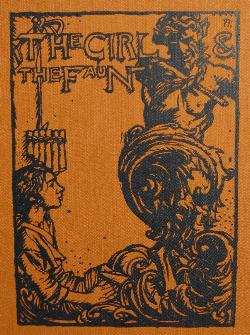
19. (Burne-Jones, Edward). (Bell, Malcolm). SIR EDWARD
BURNE JONES. London (1907): George Newnes, Quarto, 31
pages of introductory text by Malcolm Bell and 57 mounted
illustrations, plus frontispiece. Bound in original olive
green cloth with gilt titles and gilt Art Nouveau ornamental
spine. Contemporary prize label on front pastedown. Aside
from minor wear to the binding and usual foxing, a very nice
copy. $150.00
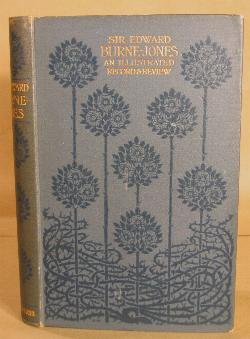
20. (Crane, Walter). Townsend, W. G. Paulson. EMBROIDERY
OR THE CRAFT OF THE NEEDLE. London: Truslove & Hanson,
1907. Second edition. A small octavo of 309 pages, bound in
the original green cloth. Aside from a name in ink on the
front free endpaper that is quite unobtrusive due to the gray
marbled paper of the endleaves, this is a fine copy. The book
retains the rare decorative dust wrapper with a lovely Art
Nouveau ornament and titles printed in black on heavy olive
green stock. The dust wrapper is soiled on the spine, otherwise
it is exceptionally bright and unchipped. Originally published
in 1899, this book was written in response to the contemporary
demands for a useful handbook on the art of embroidery. In
his preface, Walter Crane discusses the "remarkable revival
of the arts and handicrafts of design" and embroidery
as "...that most delicate and charming of them all."
The book is illustrated with a colored frontispiece and many
black and white plates, including several by Walter Crane
and one of a tapestry by Edward Burne-Jones. The book remains
a very informative work on needlecraft as well as making a
fine addition to any collection of books representing the
Pre-Raphaelites, Walter Crane or the Arts and Crafts period
of design. $125.00
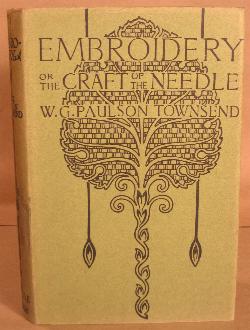
21. (Dresser, Christopher, et al). A PAIR OF AESTHETIC
MOVEMENT TILES. Stoke-on-Trent, England (1880): Minton
Hollins & Co., A pair of Minton Hollins & Co. Tiles,
circa 1880. The design is intended to be presented in pairs,
with each tile having half of an open fan and two oranges
in the corners....completing the pattern when set together.
The colors are soft apricot, black and palest mint green against
a slate green ground. We have been unable to establish with
certainty the artist of the design but the work represents
the classic elements found in the work of William Morris,
Walter Crane, Christopher Dresser and Lewis Day. The latter
three all worked for Minton Hollins during this period. The
combination of architectural and natural ornaments was the
philosophical and artistic mainstays of the Arts and Crafts
movement in England. Christopher Dresser, a student of Owen
Jones, was particularly adept at incorporating traditional
Egyptian and Asian ornamentation with Continental Art Nouveau
in a wide range of endeavors.... including pottery, metalwork,
architecture and textiles. With the exception of a few tiny
chips, none measuring over 1/16", each tile is in exceptionally
fine condition. The finish is uncompromised, with no cracks
or crazing. (Each tile 6" x 6") $250.00
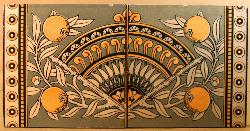
22. (Fell, H. Granville). Latham, Charles. IN ENGLISH HOMES.
London and New York: Country Life and Charles Scribners' Sons,
1904. A large folio, 419 pp., bound in original blue cloth
with strikingly handsome Art Nouveau cover design by H. Granville-Fell,
executed in gilt. Gilt spine and all edges gilt. The ornamental
title page, also the design of Granville-Fell, establishes
a noble tone for this monumental volume, with two classically
garbed architects holding the tools of their art and craft,
flanking an imposing entry with the date of the book carved
above the door. Profusely illustrated with photographs, this
is one of three volumes, published separately, in a series
featuring the finest English homes at the turn of the last
century. Aside from light edgewear, this is a superb copy
of an impressive work presented by one of the most highly
regarded publishers in British architectural and horticultural
reference books. Extra Postage Required. $300.00
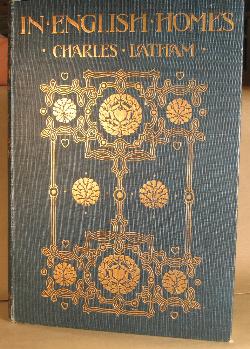
23. (Fine Binding). Sterne, Laurence. A SENTIMENTAL JOURNEY
THROUGH FRANCE AND ITALY. Philadelphia and London: J.
B. Lippincott and Chatto and Windus, 1908. Octavo, 442 pages,
illustrated by T. H Robinson. Beautifully bound in three-quarter
leather over green cloth. The spine has gilt titles and rules
as well as a pictorial panel with a gilt grape cluster and
leaves bordered with a double gilt rule. Top edge gilt. Minor
scuffing to the extremities, else a fine copy of an attractively
bound book. $125.00

24. (Granville Fell, Herbert). THE SONG OF SOLOMON.
London: Chapman and Hall, 1897. Square octavo. Bound in the
original ivory linen with elaborate gilt cover design that
is often cited as one of the most stunning examples of Art
Nouveau book design. Sixteen pages of text, each facing an
extraordinary full page illustration by H. Granville Fell.
Frontispiece, pictorial title page and colophon as well as
beautiful head and tail pieces throughout....all by this masterful
artist. $750.00
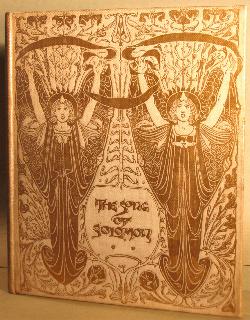
25. (Granville Fell, Herbert). Latham, Charles. THE BOOK
OF JOB. London and New York: J. M. Dent and Dodd, Mead
& Co., 1896. Bound in the original tan linen with elaborate
gilt designs on both the upper cover and spine. Containing
103 pages, the book is considered to be one of the highlights
of the Art Nouveau period. The striking black and white illustrations
by H. Granville Fell are exquisite. There are sixteen full-page
illustrations, including several double-page. Numerous textual
vignettes and ornamental borders impart the fullest sense
of beauty and power found in the lessons of the Book of Job.
Aside from browning to the endleaves, which is expected with
this title, this is a stunning copy of an important and handsome
book. $600.00
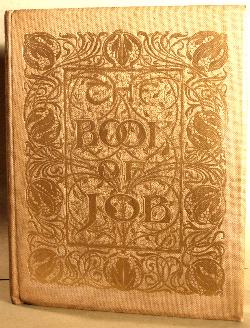
26. (Hand-painted Binding). Supino, J.B. FRA ANGELICO.
Florence: Alinari Brothers, 1902. A 12mo. bound by Giulio
Giannini of Florence in original full vellum. Elaborate hand-painted
cover and spine executed in brilliant colors and heavy gilt.
The painting of the central panel is a reproduction of Fra
Angelico's "The Annunciation" from the Convent of
San Marco. There is a one inch closed tear at the head of
the spine as well as two small areas of restoration to the
gilt on the spine. Else, a fine example indeed of an Italian
trade binding. These little gift books were done for the English-speaking
gentry visiting The Continent on their Grand Tours. $285.00

27. (Holme, Charles) (King, Jessie M.; Parrish, Maxfield;
Crane, Walter). MODERN PEN DRAWINGS. London, Paris
& New York: The Studio, Quarto, 216 pp. bound in original
blind-stamped vellum with olive green linen ties present.
Top edge gilt. Beautifully illustrated with 75 plates representing
many of the finest artists of the day...including Jessie M.
King, Maxfield Parrish, Walter Crane, Laurence Housman, and
Hugh Thomson etc. A fine copy of an impressive and desirable
book from the Arts and Crafts period of design. $900.00

28. (Italian Art Nouveau). IL LIBRO DELLE CONFESSIONI.
Firenze, (1900): G. Barbera, An oblong octavo bound in olive
green cloth over limp card, yapp edges. 236 pp. Green silk
ribbons are laced across the covers and spine, with one long
tie remaining. Exceptional Art Nouveau cover design consisting
of gilt ruled borders surrounding a rose tree in full bloom
planted in an urn with the title of the book printed on a
gilt ribbon entwined around the stem. Other gilt ornamental
foliage on the corners of the spine. A rare and captivating
Italian guest book with 28 sections of "Confessioni"
from visitors. Each "Confessioni" is comprised of
a list of 35 questions regarding the tastes, preferences and
interests of the guests. The subject matter of the queries
includes a wide and fascinating variety of subjects ranging
from literary opinions to personal defects. Printed on cream
stock with gray-green ink, each page has several questions,
a space for the answer and a variety of lovely Art Nouveau
ornamental devices. Color title page illustrated with vignettes
of a man and woman reading, with floral arrangements and ornaments
in the style of Alphonse Mucha. Five pages at the front of
the book are to be used as an index. Lovely ornamental "Fine"
closes the volume. Binding a bit shaken and some offsetting
from the ribbons on to the endleaves, else a fine copy of
a most unusual Art Nouveau book. Bellesimo! $425.00

29. (King, Jessie M). Spenser, Edmund. POEMS OF SPENSER.
London (1907): Caxton Publishing Company, A 12mo., 290 pages,
including an index of first lines. With an introduction by
William Butler Yeats. Portrait frontispiece and pictorial
title page by A. S. Hatrick. Eight full page plates by Jessie
M. King, printed on heavy stock and embellished with gilt
details. A bit of wear at the head of the spine and corner
tips....endleaves browned, else a fine copy. White 74. $200.00
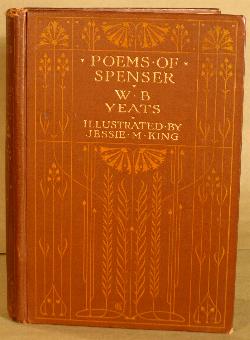
30. (King, Jessie M). Spenser, Edmund. POEMS OF SHELLEY.
London (1907): Caxton Publishing Company, A 12mo., 246 pages,
including an index of first lines. Decorative brown cloth,
top edge gilt. With an introduction by William Butler Yeats.
Portrait frontispiece and pictorial title page by A. S. Hatrick.
Eight full page plates by Jessie M. King, printed on heavy
stock and embellished with gilt details. A trace of wear and
endleaves browned, else a fine copy. White 74. $200.00
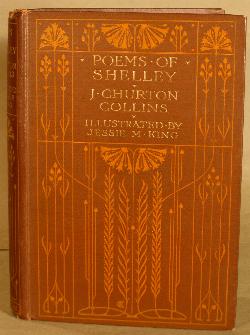
31. (King, Jessie M.). CORNERS OF GREY OLD GARDENS.
London, Edinburgh & Boston (1914): T. N. Foulis, First
Edition. An octavo of 151 pp. with eight color plates by Margaret
Waterfield mounted on heavy stock, illustrating charming essays
on gardening by various authors. White paper over boards with
a marvelous cover illustrations in vivid colors by Jessie
M. King. Top edge gilt. A companion volume to A Book Of Sundials,
this is considered by many to one of the finest examples of
Jessie King's inimitable style. Aside from some very light
soiling, this is an exceptional copy, with the boards and
gilt bright and the contents clean and free from foxing. White
112. $300.00
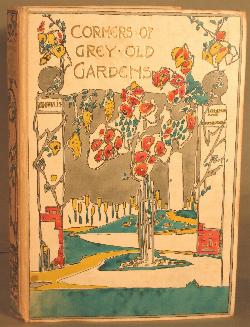
32. (King, Jessie M.) Cross, Launcelot. A BOOK OF SUNDIALS
& THEIR MOTTOES. London, Edinburgh & Boston (1914):
T. N. Foulis, First Edition. An octavo of 103 pp. with eight
color plates by Alfred Rawlings mounted on heavy stock, and
36 drawings by Warrington Hogg of notable sundials. White
paper over boards with marvelous cover illustrations in vivid
colors by Jessie M. King. Top edge green. A companion volume
to Corners Of Grey Old Gardens, this is considered by many
to one of the finest examples of Jessie King's inimitable
style. Having become quite scarce of late, particularly in
the First Edition, this is a handsome and satisfying copy.
There is a modest contemporary signature in the corner of
the front pastedown and some very minor soiling and wear.
A small bit of old cello tape is at the bottom of the spine
(1/2" x 1.5"), not particularly detracting. Offsetting
from paper between the front free endpapers. Overall, the
book requires few apologies, with the boards and gilt exceptionally
bright and the contents clean and free from foxing. White
111. $400.00
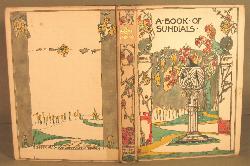
33. (Lemos, Pedro J.) Bralliar, Floyd. FLO THE EAGE AND
OTHER STORIES. Mountain View, California (1926): Pacific
Press Publishing Association, Bound in original red pictorial
cloth, this is a fine copy of a very early title in the artistic
career of Pedro Lemos, originally published in 1908. Previous
owner's inscription on the front free endpaper and the front
hinge is loose but the book is otherwise in exceptional condition.
Quite rare, particularly in this condition. Illustrated throughout
in black and white by Lemos. $65.00
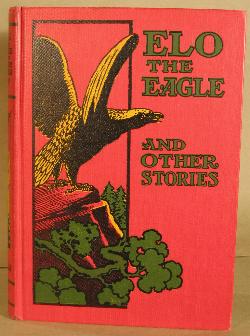
34. (MacDougal, W. B.). THE BOOK OF RUTH. London and
New York: J. M. Dent and Dodd, Mead & Co., 1896. Bound
in the original tan linen with elaborate gilt designs on both
the upper cover and spine. A companion to Granville Fell's
Book of Job, this is an exceptional example of Art Nouveau
book design. The striking black and white illustrations by
MacDougal are exquisite. There are eight full-page illustrations,
including one double-page. Numerous textual vignettes and
ornamental borders provide an exquisite presentation of the
heroic story told in The Book of Ruth. A virtually flawless
copy. (Harvard, Turn of A Century, 39). $600.00
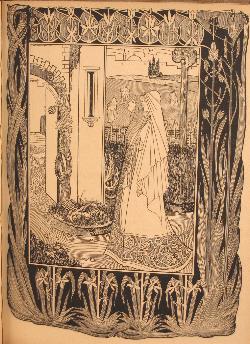
35. (Mackintosh, Charles Rennie). Lamb, Charles. LAMB'S
TALES FROM SHAKESPEARE. London, Glasgow and Bombay (circa
1915): Blackie and Son, A small octavo, 221 pages, bound in
original light tan cloth. Overall geometric pattern of stylized
birds in forest green on front cover and spine, designed by
Charles Rennie Mackintosh. Contemporary inscription on front
free endpaper and offsetting from dust wrapper flaps on endleaves.
Else, a pristine copy of the book retaining the original pictorial
dust wrapper. The dust wrapper has a white background, printed
in full color with minor edgewear and some light soiling.
A very satisfying copy of an ever-popular title, quite scarce
with Mackintosh's cover design. $150.00
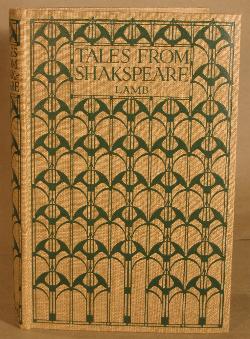
36. (Millais, Sir John Everett). Baldry, A. L. SIR JOHN
EVERETT MILLAIS Bart P.R.A. His Art and Influence. London:
George Bell & Sons, 1899. An octavo, 123 pages, including
index plus 8-page publisher's catalogue bound in at the back.
Bound in terra cotta colored cloth with Art Nouveau ornaments
on both cover and spine. Gilt titles and top edge gilt. Nicely
illustrated in black and white, this volume comprises a handsome
and useful reference on the work of one of the original members
of the Pre-Raphaelite Brotherhood. A fine copy of the second
printing of the First Edition $125.00

37.. (Millar, H. R.). THE DIAMOND FAIRY BOOK. London
(1900): Hutchinson & Co., First. Red cloth octavo, 310
pages, with a captivating cover illustration in silver and
gilt of a fairy standing atop a globe shoveling diamonds into
a child's apron. Gilt titles and silver diamonds on the spine.
All edges gilt. Illustrations by H. R. Millar enhance this
tender collection of fairy tales. A trace of fading to the
spine and rear cover, else a very good copy. $250.00
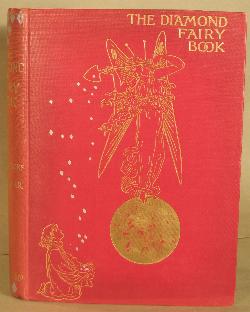
38. (Morris, Talwin). A LIBRARY OF CHOICE POETRY (TWELVE
VOLUME BOXED SET). London (1903): The Gresham Publishing
Company, A stunning Talwin Morris rarity, twelve volumes,
12 mo., bound in buff cloth and housed in ORIGINAL PRINTED
BOX. Classic Glasgow design of stylized roses and foliage
executed in gilt and olive green adorn upper cover, repeated
on the spine. Top edge gilt. The ornamental motif is carried
through to the title page, pastedown and endleaves of each
volume; printed in pink, enamel green and black. (See Cinamon
& Rodger and Archie MacSporran). The poets represented
in the collection are; Robert Browning, E. B. Browning, H.
W. Longfellow, John Keats, Christina Rossetti, Percy Bysshe
Shelley, Alfred Lord Tennyson, John G. Whittier, William Wordsworth,
Matthew Arnold and Robert Burns. Each volume has a portrait
frontispiece of the poet and an introduction preceding the
selections. Single titles of these handsome volumes are not
terribly difficult to find. To have them all together, in
pristine condition is a challenge.....but to find them in
the original box is a happy and rare circumstance indeed.
The clamshell box is covered in green linen with "A Library
Of Choice Poetry" stamped in gilt on the top. The names
of the poets are listed on a paper label on the inside of
the lid bordered in triple rules of olive green. New red ribbon
laid-in for removal of the books. Aside from some minor soiling
and wear the box is in very good condition, accounting for
the flawless condition of the volumes contained within. The
chaste design employed on these bindings is Talwin Morris
at his very best. $2,250.00
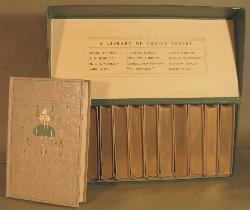
39. (Morris, Talwin). (Watson, William, editor). THE GARDENER'S
ASSISTANT. A Practical And Scientific Exposition Of The
Art Of Gardening In All It's Branches. Six Volumes. . London:
The Gresham Publishing Company, 1908. First Edition. This
six volume set is uniformly bound in forest green cloth with
white "Glasgow Style" flowers and leaves on a stylized
trellis frame of pine green contrasting with the darker background,
designed by Talwin Morris. Gilt spine titles. All volumes
have some foxing on the preliminary pages and the spine of
the last volume is a bit faded. Else, this is a very nice
set of one of the designs Talwin Morris produced for Gresham.
The set contains a wealth of information for the gardener
and is beautifully illustrated with black and white line drawings,
photographic images and several full-page chromolithographic
plates of flowers, fruits and vegetables. $325.00

40. (Morris, Talwin). Davidson, C. R. THE BOOK OF THE HOME.
Eight Volumes. London (1900/01): Gresham, Uniformly bound
in dark turquoise cloth with exquisite Art Nouveau design
of stylized peacocks by Talwin Morris on both front and rear
covers and spines executed in sage green, cream and gilt.
This set is highly desirable, with the text affording an extraordinary
range of information regarding the organization and running
of a fine home at the turn of the last century, the bindings
providing a superb example of the brilliant aesthetic qualities
that came to be known as "Glasgow Style" with many
illustrations representing the Arts and Crafts period of design
including, architectural, landscaping and interior details.
Each volume has a frontispiece in full color representing
elements of fine living, with four of the plates illustrating
fully furnished rooms designed by the well-regarded London
firm of S. J. Waring and Sons. Waring, along with Liberty,
was one of the leaders in offering the new and rather radical
designs of the Arts and Crafts movement to the public. Three
of these frontispieces, The Nursery, The Morning Room and
The Dining Room are quite amazing in their detailing of stenciled
walls, carpets, pottery and fabrics as well as furniture.
Liberty & Co. is also represented in the set. Aside from
browning to the grey endleaves and a bit of very minor foxing
and edgewear, this is a superb, bright set...difficult to
find with all volumes present and in fine condition. $650.00
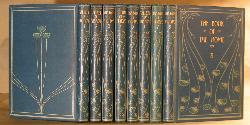
41. (Morris, William, Taylor, E. A., et al). Duncan, J. H.
Elder. THE HOUSE BEAUTIFUL AND USEFUL Being Practical
Suggestions On Furnishing and Decoration. London, Paris, New
York and Melbourne: Cassell & Company Ltd., Quarto bound
in publisher's limp sage green cloth, printed in black and
orange. The back cover is a full-page advertisement for the
firm of Roger Dawson, 1 Berners Street, Oxford. Containing
224pp. plus illustrated ads. Colour frontispiece of "Evenlode",
a William Morris design for chintz. A wealth of black and
white and half tone drawings and photographic reproductions
of every element required to furnish and decorate an Arts
and Crafts period home. This rare reference book discusses
the elements of modern home decor in detail as well as offering
some historical perspective on antique furniture. The products
and designs offered include the work of some of the most noted
artists, craftsmen and firms of the day, including William
Morris, C. R. Ashbee, E. L. Luytens and E. A. Taylor. The
covers and preliminary pages have some soiling and wear but
this fragile reference work is sound and complete....quite
rare and a most desirable book for anyone interested in the
Arts and Crafts movement. $325.00
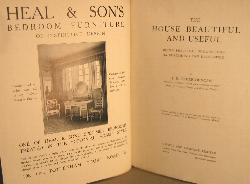
42. (Shaw, Byam). THE TAMING OF THE SHREW. London:
George Bell & Sons, 1902. A very attractive example of
an Art Nouveau binding, 16 mo., 120 pp., includes glossary
of terms and notes. Slate green cloth with elaborate gilt
cover ornament of stylized tulip buds and foliage in an interlacing
pattern surrounding the gilt title "The Chiswick Shakespeare".
Ornament is repeated on the spine along with the title of
the book, in gilt. Top edge gilt. Printed at the Chiswick
Press. As with other literary classics, it was not unusual
to publish these small gift volumes separately, promoting
the collection of the entire set...which offers a great challenge
for today's collector. Illustrated with five bold black and
white plates, including frontispiece, by Byam Shaw. Shaw also
did the ornamental title page and several textual vignettes.
There is a trace of edgewear and some scattered foxing, else
a fine copy of a charming little volume. $35.00

43. (Shaw, Byam). BALLADS AND LYRICS OF LOVE. (London):
Chatto and Windus, 1908. An octavo, 178 pages, plus glossary.
Bound in original green cloth with gilt titles on spine and
front cover as well as a charming gilt cupid with his quiver
of arrows. Top edge gilt. Aside from some browning to the
front endleaves and a small previous owner's name on the front
pastedown, this is a fine copy. Frontispiece and nine full-page
illustrations in color by Byam Shaw, capturing the artist's
ever-present sense of high romance. $85.00

44. (Shaw, Byam). LEGENDARY BALLADS. (London): Chatto
and Windus, 1908. An octavo, 178 pages, plus glossary. Bound
in original red cloth with gilt titles on spine and front
cover as well as a gilt knight upon his steed. Top edge gilt.
Some browning to the front endleaves, a small previous owner's
name on the front pastedown and some very minor spotting,
else a fine copy. Frontispiece and nine full-page illustrations
in color by Byam Shaw, capturing the artist's ever-present
sense of high romance. $75.00
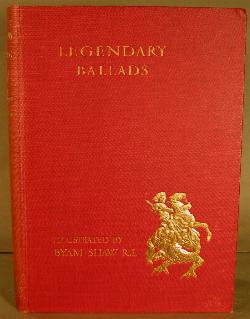
45. (Shaw, Byam). TALES FROM BOCCACCIO. London: George
Allen, 1899. First Edition Thus. Square octavo of 117 pages
bound in green cloth with outstanding Arts and Crafts cover
design in black, red and gilt. Shaw's illustrations seem to
combine the force of Will Bradley and the medieval romance
of William Morris to achieve a style uniquely his own. An
outstanding copy of a stunning trade binding. $200.00

46. (Shaw, Byam). Shakespeare, William. LOVE'S LABOURS
LOST. London: George Bell & Sons, 1901. A very attractive
example of an Art Nouveau binding, 16 mo., 122 pp., includes
glossary of terms and notes. Slate green cloth with elaborate
gilt cover ornament of stylized tulip buds and foliage in
an interlacing pattern surrounding the gilt title "The
Chiswick Shakespeare". Ornament is repeated on the spine
along with the title of the book, in gilt. Top edge gilt.
Printed at the Chiswick Press. As with other literary classics,
it was not unusual to publish these small gift volumes separately,
promoting the collection of the entire set...which offers
a great challenge for today's collector. Illustrated with
five bold black and white plates, including frontispiece,
by Byam Shaw. Shaw also did the ornamental title page and
several textual vignettes. There is a trace of edgewear, else
a fine copy of a charming little volume. $35.00
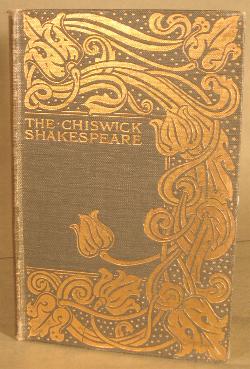
47. (Smith, Jessie Wilcox). Macdonald, George. AT THE BACK
OF THE NORTH WIND. New York: David McKay, 1919. A fine
copy of the first edition in scarce dust wrapper with some
soiling and wear. The pictorial pastedown on the front cover
is most often found with scratches and other problems. This
copy is exceptionally nice. $350.00
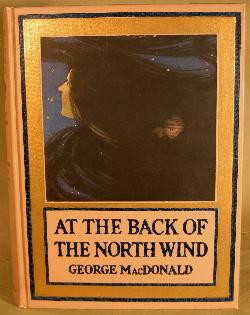
48. (Smith, John Moyr). (Tennyson, Alfred Lord). ART TILE
FROM IDYLLS OF THE KING. "VIVIEN". Stoke-on-Trent,
England (1875): A fine English Art tile, with an alluring
illustration in a circular vignette of Vivien dancing before
Merlin. Celtic knots in each corner of the tile. Executed
in dark brown and butternut tan against a cream colored ground.
From a series of twelve tiles designed by Moyr for Mintons
China Works illustrating The Idylls of the King. Measuring
6" by 6", the tile is firmly mounted in a solid
contemporary pewter trivet frame, standing one inch high.
The pewter is darkened, gratefully escaping a cleaning from
an unknowing hand. Signed by the artist in the design. A very
unusual combination of characteristics.beautiful, original
and practical for everyday use. A handsome accompaniment to
a collection of English literature. $350.00
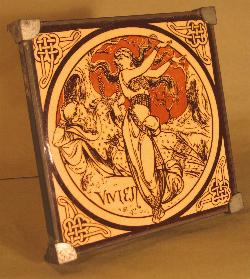
49. Burnett, Frances Hodgson. MY ROBIN. New York (1912):
Frederick A. Stokes, A charming 12 mo., 42 pages, bound in
green cloth with gilt titles on the cover and spine. Illustrated
by Alfred Brennan, including a lovely frontispiece in full
color. The frontispiece illustration is repeated on the dust
wrapper. The book is in fine condition, the dust wrapper worn
and chipped including the loss of a small triangular piece
from the margin of the lower panel. The illustration on the
cover of the dust wrapper remains complete, clean and bright
and the 50-cent price is intact on the front flap. A nice
copy of a tender story. $85.00
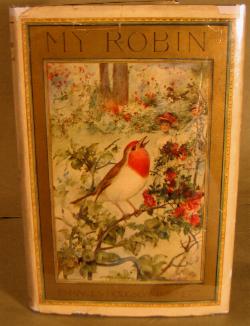
50. Caxton, William (Steele, Robert). RENAUD OF MONTAUBAN.
London: George Allen, 1897. An octavo, 283 pp., bound in tan
cloth with a lovely Art Nouveau design on the cover and spine.
Exceptional bold illustrations in black and white by Fred
Mason with borders in the Pre-Raphaelite style. Dedicated
to Walter Crane. Endleaves browned and some minor soiling
to the cover, else a very good copy of a handsome book. $120.00
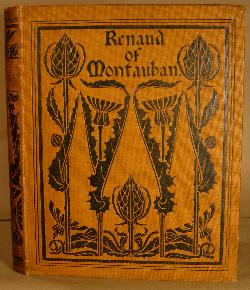
51. Collingwood, W. G. RUSKIN RELICS. London: Isbister
& Company Limited, 1903. A small quarto, 232 pages, including
index. Bound in an attractive Art Nouveau publisher's binding
of navy blue cloth with gilt ornamental upper cover and spine
motifs comprised of stylized flowers and interlaced Celtic
strapwork. This is the second English edition, containing
a chapter not found in the first edition of 1901. The book
offers an affectionate collection of text, photographs and
drawings, providing a fascinating look into John Ruskin's
life. There are fourteen chapters, the first being "Ruskin's
Chair", the last "Ruskin's Isola"...with such
captivating subjects as "Ruskin's "Cashbook",
"Ruskin's Music" and "Ruskin's Library".
The endleaves are browned and there is a bit of light wear
to the binding, particularly at the spine extremities. It
remains a very satisfying copy of a most intriguing book.
$125.00
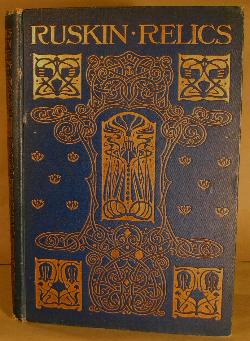
52. Crane, Walter. QUEEN SUMMER: OR THE TOURNEY OF THE
LILY & THE ROSE. London, Paris & Melbourne: Cassell
& Co: Ltd., 1891. First Edition. A slim quarto bound in
original cream colored cloth over pictorial paper covered
boards, 40 pages, plus six page publisher's catalogue bound
in at the back. Each page is illustrated in delicate colors
by Walter Crane, printed on one side only on French fold sheets.
These fragile books, many of which were intended to be parted
and used in decorative screens and friezes, are usually found
in compromised condition, including heavy soiling and foxing.
This copy has not wholly escaped the troubles of its companions,
with general overall soiling to both covers and spine as well
as some wear to the extremities, particularly the corners.
The lime green, terra cotta and cream cover designs are in
satisfactory condition and the contents are exceptionally
clean and bright, totally free from foxing or stains. The
salmon colored patterned endleaves are also bright, with the
charming bookplate of Birmingham School artist H. Isabel Adams
affixed to the front pastedown. A very pleasing association
copy of a beautiful book from one of the leaders of the British
Arts and Crafts movement. $350.00
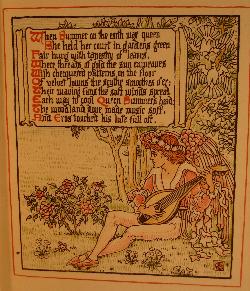
53. Daniels, Fred Hamilton. THE FURNISHING OF A MODEST
HOME. Boston, N.Y., Chicago and Dallas (1908): Atkinson,
Mentzer & Company, First Edition. Bound in original tan
cloth with dark forest green pictorial cover and titles, 16
mo., i-xiii, 14 - 137, iv pages. This little book has become
a classic in the study of Arts and Crafts aesthetics. The
discussions of what constituted a tasteful home reflecting
simplicity and rebellion against Victorian excess are admirably
bold in nature. Nicely illustrated with line drawings and
photographic images. The book enjoyed popularity when it was
first written, reprinted shortly after it first appeared.
It is now available in modern reproductions. This is a fine
copy of the First Edition. $125.00
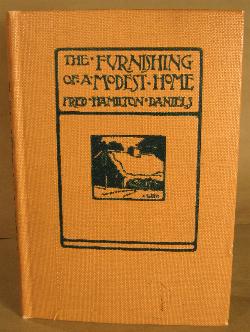
54. , Arts and Crafts, Tile, Pottery. A rare and particularly
handsome William De Morgan tile. Measuring 6" x 6",
this tile has exceptional coloration and classic de Morgan
aesthetic details divided into quadrants, with ornamental
motifs of purple stylized flowers and lovely green foliage.
The design reflects the artist's commitment to the work of
A.W.N. Pugin and Owen Jones. The bottom edge has some chipping
with approximately 1/8 to ¼ inch loss. Upper left corner
lightly chipped. Minimal crazing. A very satisfying example
of a British art tile from an esteemed leader of the Arts
and Crafts movement in England. $650.00
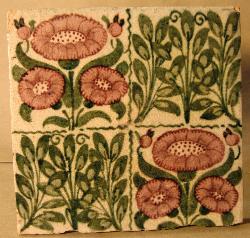
55. Delamotte, F. THE EMBROIDERER'S BOOK OF DESIGN.
Initials, Ciphers, Ornamental Borders, Emblems, Ecclesiastical
Devices, Monograms, Alphabets Mediaeval and Original, National
Emblems, etc. etc. London: E. & F. N. Spon, 1860. Oblong
octavo containing 19 pages printed on one side only. Bound
in original cloth-backed boards with elaborate pictorial cover
printed in brown red and green. The back cover, printed in
brown, is an advertisement for two of Delamotte's other design
books: Ornamental Alphabets Ancient and Modern and Modern
Alphabets Plain, with descriptions and prices. The books relating
to lettering as well as the author's Primer on Illumination
are desirable but not particularly difficult to find. This
title is quite rare in any condition, with this copy exhibiting
only minor wear and some light soiling. Each page illustrates
a wide range of patterns for needlework; each printed in a
different color....either blue, purple, brown, red or black.
Laid in are several hand done patterns by a former owner,
adding to the charm of this exceptional design book. $500.00
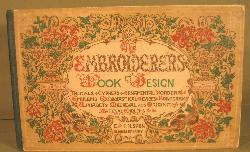
56. Earle, Alice Morse. OLD TIME GARDENS. New York:
The Macmillan Company, 1901. Original gray cloth with elaborate
cover and spine design of a white sundial standing amongst
towering pink hollyhocks with pale green stems. The entire
design is bordered in white. Top edge gilt. Some light rubbing
and wear to covers and spine a bit faded, else a very good
copy of a most desirable book in the First Edition. $125.00
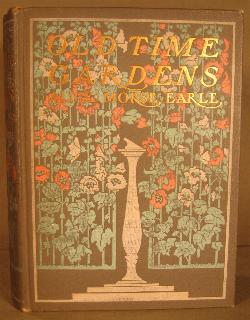
57. Greenaway, Kate. LANGUAGE OF FLOWERS. London (1884):
George Routledge, 12mo, green glazed pictorial boards, green
spine, yellow edges, bright yellow endpapers, 80p., light
cover soil and wear to the extremities, else a very good copy
of the First Edition (Schuster 107-1i). Beautiful color illustrations
throughout by Greenaway, engraved by Edmund Evans. $400.00
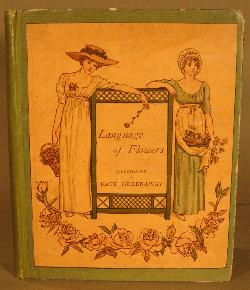
58. Hubbard, Alice. AN AMERICAN BIBLE. East Aurora,
N. Y. (1911): The Roycrofters, This is a near fine copy of
a book often found in compromised condition. It is a 444-page
octavo printed in red and black with the original smooth calf
binding. The binding has mellowed to a lovely dark brown with
the original blind stamping Art Nouveau design on the cover
and spine crisp and clean. Interesting inscription on blank
prelim otherwise bright and unmarked internally. This volume,
of course, is not the King James Bible but a series of essays
by Franklin, Jefferson, and Uncle Walt etc. $300.00

59. Hubbard, Elbert. HOLLYHOCKS AND GOLDEN GLOW. East
Aurora, N. Y. (1912): The Roycrofters, This is a beautiful
copy of an early edition bound in the original embossed leather
binding with elaborate blind stamped panels of flowers and
vines. It is an octavo of 157 pages, decorated with head and
tailpieces in black and white. Portrait of Hubbard tipped
in as frontispiece with facsimile signature below. Aside from
a bit of fading to the spine and the slightest edge-wear this
is a clean unworn copy. $325.00

60. James, George Wharton. UTAH The Land of Blossoming
Valleys. Boston: The Page Company, 1922. A stout octavo
of 371 pages, including index. Bound in original forest green
cloth with exceptional Art Nouveau illustration on the cover,
executed in pale pink, lavender, light green and gilt. Top
edge gilt. The fourth title in Page's series, "See America
First, the book contains a map and fifty-six plates, of which
eight are in color. A pristine copy of a handsome book. $125.00

61. King, Jessie M. ALBUM VON BERLIN. Berlin: Globus
Verlag, 1904. An uncommonly small size for this title, an
oblong octavo, measuring 6" by 8". The cover design
is one of four, which comprise Jessie King's first large commission.
First appearing in 1899, the cover was used on several subsequent
albums featuring photographic images of German cities. Colin
White says of this design, "...one of Jessie's most imaginative
conceptions. Combining German orderliness with Scottish fantasy,
it set the Imperial Eagle in a framework of climbing rosebushes
with clusters of petals stylized like so many iron crosses."
" Bound in gray paper over boards, this is a small version
of the more easily obtainable quarto edition of the same title
and design. The back cover has the letter " V "
in the middle of a small globe. The paper is over white cloth,
revealed in this copy by some light edgewear and two small
chips, (the largest measuring less than one-half inch), on
the extremities of the spine. Despite some light overall soil,
the cover illustration executed in black, slate blue, gilt
and a touch of orange, is exceptionally bright. Lovely patterned
endleaves of clusters of grapes and vines. The contents are
fine, bright and totally sound. A nice example of an early
Jessie King item. White, pp.34, 35,36; B1-iv, De Beaumont
1, (1899). $300.00

62. McKenna, Ethel M. M. (editor). THE WOMAN'S LIBRARY
(Six Volumes). London: Chapman and Hall, 1903. Six volumes,
comprising an extremely scarce complete set of The Woman's
Library, edited by Ethel M. M. McKenna. Small octavos, bound
in a soft turquoise cloth with titles and decorative devices
on the upper cover and spine executed in sharp, pure white.
Each volume lists the names of the authors contained within
on the front cover, surrounded by a heart. The books are very
attractive, with a distinct Arts and Crafts style, signed
with a capital "M" and four dots that we assume
to be the monogram of Ethel M. M. McKenna. The volumes are
as follows: Vol. I ( 368 pp., including index): EDUCATION
AND PROFESSIONS By Janet E. Hogarth, Beatrice Orange, Louise
Jopling, Mary Frances Billington, Madge Kendall, Ethel F.
Lamport, MD, Margaret H. Irwin and Mabyn Armour. Vol. II (312
pp., including index): NEEDLEWORK By Miss J. E. Davis, Miss
Ruth M. Day, Miss Clare Hill, and Mrs. Turnbull & Miss
Turnbull. Vol. III (286 pp. including index): NURSERY &
SICKROOM By Lady Isabel Margesson, Dr. Ethel Lamport &
Miss H. F. Gethen. Vol. IV (327 pp., including index): SOME
ARTS AND CRAFTS By May Crommelin, Mrs. R. Barton Shaw, Maria
E. Reeks, Elinor Halle, A. M. Clive Bayley, Ethel M. M. McKenna
and Alice Hughes. Vol. V (311 pp., including index): COOKERY
AND HOUSEKEEPING By Mrs. Praga. Vol. VI (346 pp., including
index): THE LIGHTER BRANCHES OF AGRICULTURE By Edith Bradley
and Bertha La Motte with an Introduction by The Countess of
Warwick. This collection of essays, written by some of the
most successful women of the day, offers historical perspective
on the education and social circumstance of females in England.
All of the authors were active in the movement for women's
rights, with these volumes particularly addressing the question
asked by families in a broad spectrum of financial means,
"What are we to do with our girls?" The gentry considered
education for their sons a serious topic indeed, in order
to secure associations and degrees that would propel them
to the proper heights. Education for a girl, on the other
hand, was still primarily seen as an enhancement to her ability
to attract a husband. This set of books lives up to the title
of the collection..."The Woman's Library"...providing
encouragement to young women to seek the satisfaction of useful
and gainful work with proper training and apprenticeships....much
in the same manner Ashbee, Morris and other social and artistic
luminaries encouraged young men. The Countess of Warwick,
"Daisy"....promoted the establishment of hostels
where girls could learn the skills required for respected
engagement in the rural pursuits of market gardening, beekeeping
and other avenues that would offer independent employment.
Madge Kendal, who would become Dame Madge Kendal in honor
of her work in the theatre both on and off stage, writes with
wit and candor about, 'The Theatrical Life." Medicine,
Art, Journalism and virtually every other skilled profession
undertaken by males is discussed with regards to the requirements
for success. The tuition rate and availability of scholarships
are given for many institutions, including Cambridge and Oxford.
Louise Jopling, the first woman elected to the Royal Society
of British Arts writes a fine and noble essay about Art as
a necessity in a balanced society. She indicts the staid and
entrenched values of English men for bringing the country
to its position of disregard in comparison to artistic achievements
of other nations. Ethel McKenna offers a marvelous chapter
on Bookbinding, with an emphasis on the work of The Guild
of Women Binders. Single volumes of this set are scarce on
their own....with the complete group of six a rare prize indeed.
Aside from foxing to the edges and endleaves, this is a fine
bright set of an important collection of work in the progression
of the women's movement, housed in elegant cloth bindings.
$1,500.00

63. Morris, William. SOME HINTS ON PATTERN
DESIGNING. London: Longman's and Co., 1899. A slim octavo,
45 pages, bound in linen-backed paper over boards. Printed
at the Chiswick Press with the Golden type designed by William
Morris for the Kelmscott Press. A touch of wear to the corners
and light browning to the endleaves, else a fine copy of a
lecture delivered by William Morris at the Working Men's College,
London, December 10, 1881. $150.00
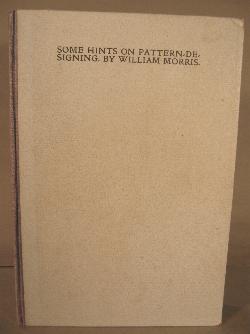
64. Rossetti, Christina. VERSES. London: Society For
Promoting Christian Knowledge, 1904. An octavo bound in dark
brown cloth with gilt titles on upper cover and spine. Top
edge gilt. Aside from light edgewear, this is a fine copy.
Beautifully printed with red linear borders on each page.
$75.00

65. Rossetti, Dante Gabriel. THE POEMS OF DANTE GABRIEL
ROSSETTI. London: Ellis, 1908. A small octavo, 711 pages,
edited by the author's devoted brother, William M. Rossetti.
This captivating little pocket edition of Rossetti's poems
is sympathetically bound in quarter vellum over brown cloth.
The smooth calf spine label reflects the influence of the
Arts and Crafts movement on bookbinding, with simple letters
in gilt. Below the label is a gilt ornament consisting of
two tiny flowers linked with gilt leaves and ruled stems...the
longest one supporting a gilt daisy blossom. Engraved frontispiece
of the poet. There is a faint, small stamp on the verso of
the front free endpaper, "The Times Book Club Oxford
Street". Aside from a trace of foxing and wear at the
corners this is a fine presentation of Rossetti. A discreet
inscription on the front free endpaper dated 2nd July 1910
enhances the romantic subject and binding: "To my own
darling Gladys, from her true lover Edward." $250.00

66. Rossetti, Dante Gabriel. EARLY POEMS OF DANTE GABRIEL
ROSSETTI. London (1908): Grant Richards Ltd, 24mo - over
5" - 53/4" tall. A charming, diminutive volume of
Rossetti's early poems, before the author altered them as
he achieved more skill and sophistication. Original scarlet
cloth, 83 pp., with Art Nouveau floral motifs in blind on
the upper cover. Frontispiece, "The Blessed Damozel"
after the painting by Rossetti. Originally published in December
1906, this is the second edition. Red cloth bindings are notorious
for fading, particularly the spine. This copy of a scarce
little volume is without fault...very satisfying to hold and
read. $50.00
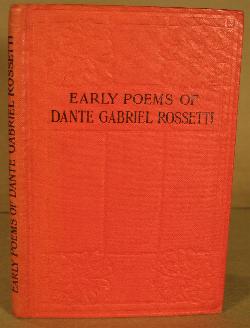
67. Ruskin, John. UNTO THIS LAST. London, (1909): George
Allen & Sons, A superb Art Nouveau binding with a strong
Arts and Crafts influence, with a tantalizing link to John
Ruskin. This slim 16mo of 199 pages is bound in full calf
of deepest burgundy with a cover design in gilt of a stylized
trellis with six repeating squares containing a single blossom
and foliage, repeated on the spine. All edges gilt. This superb
little volume contains some of Ruskin's most penetrating essays
on the nature of Man, originally published in the Cornhill
Magazine. Affixed to the front pastedown is a presentation
notice explaining that John Ruskin had revived "...an
Old-World ceremony (at Whiteland's College) of The Crowning
of the Queen of the May and dignified the occasion by presenting
a beautifully wrought gold cross, to be worn by the Queen.
He also gave many purple calf-bound volumes of his work to
be distributed to her subjects. Since his death, the quaint
old ceremony has been kept up, by a few of those who knew
and loved him, in the spirit in which it was instituted, and
in honour of his name." The May Day ceremony remains
the most important event of the year at Whitelands. This book
was presented to Daisy Cooke, Queen of the May 1912. Ruskin
was one of the most important Friends of the College, donating
hundreds of books and pictures to the institution. He persuaded
Edward Burne-Jones to design windows for the College chapel
and William Morris to make them. Aside from a trace of wear
to the spine extremities, this is a very fine copy indeed
of a very special edition. Ruskin died in 1900 and although
there is no binder's mark, we believe this copy was specially
bound in deepest purple to carry on the tradition of the May
Queen. $300.00
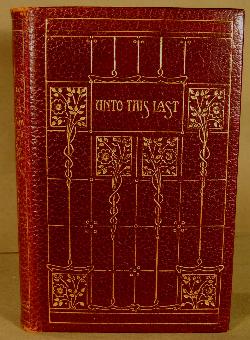
68. Ruskin, John. SESAME AND LILLIES. London: George
Allen, Ruskin House: Charing Cross Road, 1902. A collection
of three lectures presented in 1871 by the Mentor of the Pre-Raphaelite
Brotherhood, so inspired they have been bound countless times
in various formats and designs. An octavo of 228 pages, including
index. This copy, reprinted from the first "small edition"
of 1893 is particularly sympathetic to the ideals of Mr. Ruskin.
Bound in half navy blue calf over light blue boards with six
paneled spine exquisitely embellished with gilt lilies and
foliage. Top edge gilt, marbled endleaves. Although the binding
is unsigned, it is of the quality one would expect from Riviere
or Sangorski and Sutcliffe. It has a decided Arts and Crafts
flavor with flat broad bands on the spine and stylized floral
motifs, in the style of Cobden-Sanderson. Aside from some
minor rubbing to the spine extremities, this is a fine copy
of a beautiful and satisfying edition of one of John Ruskin's
most beloved titles. $300.00

69. Shelley, Percy Bysshe. POETICAL WORKS (Two Volumes).
London: Reeves & Turner, 1882. 572 pp.; 580 pp., plus
14-page publisher's catalogue bound in the back of the second
volume. Original light brown cloth with aesthetic movement
pictorial covers featuring the pleasures of Heaven and Earth
found in the sun, stars, wildflowers with two opposite corners
occupied by a butterfly and bird in flight, all in gilt. Engraved
portrait frontispiece in the first volume. Aside from minor
wear and some foxing to the endleaves, this is a very nice
set containing the highly esteemed editorial work of H. Buxton
Forman. $250.00
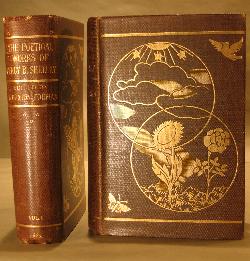
70. Swanson, Margaret and MacBeth, Ann. EDUCATIONAL NEEDLECRAFT.
London, New York, Bombay and Calcutta: Longmans, Green and
Co., 1913. Bound in original blue cloth, this is a very good
copy of a rare title representing the work of Ann MacBeth,
one of the leading figures of the Scottish Arts and Crafts
movement that was centered in Glasgow. Miss MacBeth was an
accomplished student at the Glasgow School of Art and went
on to become the head of the School of Needlework at the highly
esteemed institution. Her contemporaries, also luminaries
of the Glasgow School, were Charles Rennie Mackintosh, Talwin
Morris and Jessie M. King. Books of this period by Ann MacBeth
are very elusive, particularly in original cloth. This copy
of an early printing is in lovely condition with the only
faults being browned endleaves and some minor rubbing along
the spine. Eight full-page color plates and numerous line
drawings illustrate the book with representations of the favored
ornamental style of the day. The finely written text affords
not only instruction for the various projects but offers a
commentary on the appalling conditions of child labor and
the limited opportunity for females. A scarce and important
volume from the Arts and Crafts period of design. $225.00

71. Tennyson, Alfred Lord. THE POETICAL WORKS OF ALFRED,
LORD TENNYSON. London and Glasgow (1903): Collins' Clear
Type Press, A stout octavo of 692 pages, including an index
of first lines. Bound in three-quarter vellum over sage green
cloth, this is one of the most attractive volumes of Tennyson's
poems that we have seen in some time. Although unsigned, it
is superior both in craftsmanship and the quality of the vellum
and gilt. The gilt design on the spine has a strong Arts and
Crafts flair, constituted by chaste ruled lines forming the
stems of small tulips and leaves. The design is supported
by the choice of font and the arrangement of the gilt title
on a label of smooth butterscotch calf. The vellum on both
covers is bordered with a single gilt rule. Top edge gilt.
Nicely illustrated in color and black and white by several
artists, including Arthur Dixon and Herbert Cole. Of particular
interest is a folding color plate of Sir Launcelot and Queen
Guinevere from the original painting in the National Gallery
of Art by Sir Edward Burne-Jones. Aside from a couple of small
marks on the lower cover, this is an exceptional volume of
Tennyson's work. $450.00

72. Ward, James. COLOUR DECORATION OF ARCHITECTURE.
London: Chapman and Hall, 1913. Bound in original brick red
cloth with decorative cover and gilt spine. Trace of wear
to the extremities, discreet previous owner's signature, else
a fine copy of the First Edition. James Ward contributed several
books to the field of design and ornament during the Arts
and Crafts period, including Principles of Ornament and Progressive
Design. This volume contains twelve illustrations in colour
and twenty-two in half tone. $85.00

73. Whitman, Walt. LEAVES OF GRASS. Philadelphia: David
McKay (1900), First Thus. Octavo. Bound in original forest
green cloth with decorative Art Nouveau cover and spine in
gilt and black. (x); 11-489; (xi). Top edge gilt. Extremities
rubbed and gilt on spine a bit dull, nevertheless a handsome
copy, with portrait frontispiece of Uncle Walt and a facsimile
of the poet's Biographical Note bound in. $125.00

NEW! We
will host and promote an online exhibition for you. If you
have an exhibition planned, that relates to the Decorative
Arts 1850-1920, we can host your exhibition website and promote
the selling exhibition with you.
A BRIEF HISTORY OF
ARTS & CRAFTS BOOKS AND BOOK DESIGN
T.J. COBDEN-SANDERSON
Thomas James Cobden Sanderson (1840 - 1922)
was a British artist and bookbinder associated with the Arts
and Crafts movement.
Born in Alnwick, Northumberland, Cobden Sanderson attended
many schools including the Royal Grammar School Worcester
before entering Owen's College (Manchester University) and
then Trinity, Cambridge to study law. He left without taking
a degree, and entered Lincoln's Inn as a barrister.
As a friend of William Morris, Cobden Sanderson was involved
with the Arts and Crafts ideology and during a dinner party
with the Morrises he was persuaded by Janey (wife of William
Morris) to take up book-binding. In 1884 he opened a workshop
and in 1900 the Doves Press was founded by him along with
Emery Walker in Hammersmith, London. They produced books for
William Morris, including the famous Doves Bible in 1903.
A special font known as the Doves Type was used by the press,
but when the press closed in 1916 Cobden Sanderson threw the
font type into the Thames.
THE DOVES PRESS
Doves Press was a small printing company based
in Hammersmith, London between 1900 and 1916. It was founded
by Thomas Cobden-Sanderson and Emery Walker, with Walker designing
the press's type and Cobden-Sanderson working in the bindery.
It is considered to have been a significant contributor to
the arts and crafts movement; the founders had been associated
with William Morris and the Kelmscott Press. The type used
by the press was created by Emery Walker, based on the designs
of Jenson. The fonts were destroyed by Cobden-Sanderson in
1916 when he threw them off Hammersmith bridge one night,
and the company closed soon after. The company was named after
"The Dove" an old riverside pub in Hammersmith.
The Doves Press was responsible for the Doves Bible, which
is considered to be one of the best examples of its type.
THE KELMSCOTT PRESS
In January 1891, Morris founded the Kelmscott Press at Hammersmith,
London, in order to produce examples of improved printing
and book design. He designed clear typefaces, such as his
Roman 'golden' type, which was inspired by that of the early
Venetian printer Nicolaus Jenson, and medievalizing decorative
borders for books that drew their inspiration from the incunabula
of the 15th century and their woodcut illustrations. Selection
of paper and ink, and concerns for the overall integration
of type and decorations on the page made the Kelmscott Press
the most famous of the private presses of the Arts and Crafts
movement. It operated until 1898, producing 53 volumes, and
inspired other private presses, notably the Doves Press. Among
book lovers, the Kelmscott Press edition of The Canterbury
Tales is considered one of the most beautiful books ever produced.
DOUGLAS COCKERELL
Douglas Bennett Cockerell (1870-1945) was born in Sydenham,
England. Early indications definitely did not point to his
future career as a master bookbinder, who would revolutionize
modern bookbinding and be entrusted with rebinding some of
England's most precious manuscripts. Cockerell hated school.
His widowed mother decided real life experience might be his
best schooling. At fifteen and with 5 British pounds in his
pocket, Douglas was sent out to Canada to find his way. For
the six years he spent in Canada, Cockerell first worked as
a farm hand, then as a wool carder, and finally as a bank
clerk. In 1891 Cockerell returned home to England with lots
of life experience and a very clear idea of what he did not
want to do for a living.
Back in England, Douglas was introduced to the book arts by
his brother Sydney, the private secretary to William Morris
of the Kelmscott Press. In March 1893, Douglas entered a four
year apprenticeship with T.J. Cobden-Sanderson at the Doves
Bindery in Hammersmith. From Cobden-Sanderson, Douglas learned
the importance of combining quality materials with technical
skill and creativity. Based on his research of older binding
styles, his own design ideas, and his innovative approach
to the technical aspects of handbinding, Cockerell developed
his own distinctive style. His insistence on sound book structure
and his unique combinations of simple forms to create eye-pleasing
designs set new standards in bookbinding.
In 1897, Cockerell launched his own bindery in London and
took up a teaching appointment at the London County Council
Central School of Arts and Crafts. Except for the war years,
Cockerell taught these continually until his retirement in
1935. As a textbook for his students, Cockerell wrote his
influential bookbinding manual, Bookbinding and the Care of
Books (1901). He would publish two other major works on bookbinding--Some
Notes on Bookbinding (1929) and Bookbinding as a School Subject
(1939). Through his publications, Cockerell was able to persuasively
present his guiding principles for sound, creative, and responsible
bookbinding. Indeed, he was able to start a revolution.
Throughout his long binding and teaching career, Cockerell
constantly worked to improve and adapt the materials and techniques
he used. Among his accomplishments were the introduction of
higher quality African leather, the recognition of the superiority
of alum-dressed leather, the establishment of principles for
reliable conservation work, and the refinement of marbling
techniques leading to the production of a consistent, high
quality paper for endpapers.
In his essay entitled "Fine Bookbinding in England,"
published in The Art of the Book (London, 1914), Cockerell
stated:
"Fine binding ... implies that the craftsman has done
his best with the best materials. It may be plain or decorated,
but whatever work there is should be the best of which the
craftsman is capable."
Dalhousie University
ESSEX HOUSE PRESS
C.R. Ashbee founded Essex House Press in 1898 in London, England.
The press moved to Chipping Campden, Gloucestershire, England,
in 1902 and continued to operate until 1910. Ashbee was known
as a leader in the English Arts and Crafts movement of the
late nineteenth century. Like other Arts and Crafts presses,
Ashbee maintained that all aspects of the book -- type, paper,
binding, etc. -- should rise to the status of an art and adhere
to a standard of beauty.
A bibliography was published: A bibliography of the Essex
House press, with notes on the designs, blocks, cuts, bindings,
etc., from the year 1898 to 1904, by C.R. Ashbee, Campden,
Gloucestershire, Essex House press, 1904
CHARLES RICKETTS
Charles De Sousy Ricketts (1866 - 1931) was a versatile English
artist and designer, best known for his work as book designer
and typographer from 1896 to 1904 with the Vale Press, and
his work in the theatre as a set designer.
He was born in Geneva to a French mother and an English father.
He grew up mainly in France and Italy. He began his studies
in art at the City and Guilds Technical Art School in Lambeth,
in 1882, after both his parents had died.
There he met Charles Shannon (1863-1937), painter and lithographer,
who would be his lifelong partner in both his artistic and
personal life. On the advice of Pierre Puvis de Chavannes,
they settled in England rather than abroad. They founded The
Dial, a magazine, which had five issues from 1889 to 1897,
and the Vale Press, named after their house, The Vale in Chelsea,
London.
Ricketts was one of two illustrators of Oscar Wilde's work,
the other being Aubrey Beardsley who worked on Salomé.
He and Shannon were friends and supporters of Wilde.
It was in the work of the Vale Press that Ricketts would find
his talents were best employed. The enterprise also involved
Thomas Sturge Moore, and later William Llewellyn Hacon (1860-1910),
a barrister. The actual printing was carried out by Ballantyne
Press under the supervision of Charles McCall. A total of
about 75 books were produced, including a complete Shakespeare
in 39 volumes, before the special type fonts were destroyed.
In parallel, Ricketts was involved with the Eragny Press,
run by Lucien Pissarro and his wife Esther, from 1894 to 1914.
After 1902, he became a more serious painter and sculpturer.
He also wrote on art, was a collector, and became a member
of the Royal Academy in 1928. He designed sets for plays by
Wilde, Bernard Shaw and Cecil Lewis; and also the revived
Savoy Operas of the 1920s.
CHRISTINA ROSSETTI
One of the most important of English woman poets, who was
the sister of the painter-poet Dante Gabriel Rossetti, and
a member of the Pre-Raphaelite art movement. 'A Birthday,'
'When I Am Dead,' and 'Up-Hill' are probably Rossetti's best-known
single works. After a serious illness in 1874, she rarely
received visitors or went outside her home. Her favorite themes
were unhappy love, death, and premature resignation. Especially
her later works deal with sombre religious feelings.
Does the road wind uphill all the way?
Yes, to the very end.
Will the day's journey take the whole long day?
From morn to night, my friend.
(from 'Up-Hill', 1861)
Christina Rossetti was born in London, one
of four children of Italian parents. Her father was the poet
Gabriele Rossetti (1783-1854), professor of Italian at King's
College from 1831. He resigned in 1845 because of blindness.
All the four children in the family became writers, Dante
Gabriel also gained fame as a painter. Christina was educated
at home by her mother, Frances Polidori, a former governess,
an Anglican of devout evangelical bent. She shared her parents'
interest in poetry and was portrayed in the paintings and
drawings of the Pre-Raphaelites. Christina was the model for
his brother's picture The Girlhood of Mary Virgin (1849),
which was the first picture to be signed P.R.B. Jan Marsh
has proposed in her biography Christina Rossetti: A Writer's
Life (1995) that Christina was sexually abused by her father,
but "perhaps like many abuse victims she banished the
knowledge from conscious memory." However, this kind
of speculative claims become highly popular in biographies
in the 1990s.
Rossetti's first verses were written in 1842 and printed in
the private press of her grandfather. In 1850, under the pseudonym
Ellen Alleyne, she contributed seven poems to the short-lived
Pre-Raphaelite journal The Germ, which was founded by her
brother William Michael and his friends. When the family was
in a financial trouble, she helped her mother to keep a school
at Frome, Somerset. The school was not a success, and they
returned in 1854 to London. Except for two brief visits abroad,
she lived with the mother all her life.
Rossetti's deeply religious temperament left its marks on
her writing. She was a devout High Anglican, much influenced
by the Tractarian, or Oxford, Movement. Rossetti broke engagement
to the artist James Collison, an original member of the Pre-Raphaelite
Brotherhood, when he joined the Roman Catholic church. She
also rejected Charles Bagot Cayley for religious reasons.
By the 1880s, recurrent bouts of Graves' disease,
a thyroid disorder, had made Rossetti an invalid, and ended
her attempts to work as a governess. Rossetti's illness restricted
her social life, but she continued to write sonnets and ballads.
Especially she was interested the apocalyptic books, and such
religious writers as Augustine and Thomas à Kempis.
She also admired George Herbert and John Donne. Among her
later works are A PAGEANT AND OTHER POEMS (1881), and THE
FACE OF THE DEEP (1892). She was considered a possible successor
to Alfred Tennyson as poet laureate. To accept the challenge,
she wrote a royal elegy. However, Alfred Austin was appointed
poet laureate in 1896. Rossetti developed a fatal cancer in
1891, and died in London on December 29, 1894.
In 'After Death', which she wrote in 1849, the poet-speaker
lays on a bed, with a shroud on her face, observing the surroundings
before the burial. "He did not love me living; but once
dead / He pitied me; and very sweet it is / To know he still
is warm tho' I am cold." The theme of death appears next
year also in her brother's poem 'My Sister's Sleep', (1850),
in which death visits a family on a Christmas Eve. Rossetti's
best-known work, GOBLIN MARKET AND OTHER POEMS, was published
in 1862. The collection established Rossetti as a significant
voice in Victorian poetry. The title poem is a cryptic fairy-tale
and tells the story of two sisters, Lizzie and Laura, who
are tempted the eat the fruit of the goblin men. After eating
the fruit, Laura cannot see the goblins. Lizzie, whose refusal
have angered the goblins, is attacked by them, and she saves
her sister in an act of sacrifice. Laura, longing to taste
again the fruit, licks the juices with which Lizzie is covered.
"For there is no friend like a sister / In calm or stormy
weather." THE PRICE'S PROGRESS, AND OTHER POEMS, appeared
in 1866. SING SONG. A NURSERY RHYME BOOK was illustrated by
Arthur Hughes in 1872. Rossetti also wrote religious prose
works, such as SEEK AND FIND (1879), CALLED TO BE SAINTS (1881)
and THE FACE OF THE DEEP (1892).
Rossetti's brother William Michael edited
her complete works in 1904. He once said that "Christina's
habits of composing were eminently of the spontaneous kind.
I question her having ever once deliberated with herself whether
or not she would write something or other, and then, after
thinking out a subject, having proceeded to treat it in regular
spells of work. Instead of this, something impelled her feelings,
or "came into her head," and her hand obeyed the
dictation. I suppose she scribbled lines off rapidly enough,
and afterwards took whatever amount of pains she deemed requisite
for keeping them in right form and expression." Rossetti's
work has suffered from reductive interpretations, but she
is increasingly being reconsidered as a major Victorian poet.
Kirjasto
ERIC GILL
A wood engraver, sculptor, typographer, and
draughtsman, Arthur Eric Rowton Gill was born in Brighton.
He studied in Chichester at the Theological College, and then
at the Technical and Art School before moving to London and
attending the Central School.
Gill's early training there under the calligrapher and stonemason,
Edward Johnston, is reflected within the purity and severity
of his work; his forms lose all extraneous and superfluous
detail in favour of a more austere and abstract method of
representation, which has come to be recognised as neo-Byzantine
and anti-naturalistic. An equal importance laid upon lettering
and the compatibility of the engraving with any accompanying
text is also indicative of his early pupillage.
Gill lived in Ditchling, Sussex 1907-24 and
around him sprung up a community of artists. Gill's Roman
Catholic views were influential upon the community and in
1917 a religious order of artists was conceived, and in 1921
members of the community formed the Guild of St Joseph and
St Dominic (which exists today). Among the artists surrounding
him at Ditchling were David Jones, Hagreen, Pepler, and Johnston.
In 1924 he moved to Capel-y-ffin, near Hay-on Wye and over
the next four years produced much of his best engraved work.
Gill's often radical approaches set him apart
from other contemporaneous engravers: he did not stick solely
to the white-line method, nor was he afraid to experiment
with the inclusion of large areas of white in his engravings
through the cutting away of the equivalent areas from the
block.
Gill never strayed far from the religious
roots which inform his work. Eroticism also forms an important
part of it. Gill was not afraid to combine these two elements.
Among his many and varied achievements are the numerous books
he designed, both type and illustration, The Canterbury Tales
and The Four Gospels being among the greatest book productions
between the Wars.
He held a number of teaching jobs, including
gilding at the Central School and lettering at the LCC Paddington
Institute. He was a founder member of the SWE and an associate
of the RA. In 1937 he was awarded an honorary associateship
of the Royal Society of British Sculptors.
From British Printmakers 1855-1955 Garton
& Co and Scolar Press
KATE GREENAWAY
Kate Greenaway (Catherine Greenaway) ( London, March 17, 1846
- November 6, 1901) was a children's book illustrator and
writer. Her first book, Under The Window (1879), a collection
of simple, perfectly idyllic verses concerning children who
endlessly gathered posies, untouched by the Industrial Revolution,
was a best-seller.
The Kate Greenaway Medal is awarded annually by the UK Chartered
Institute of Library and Information Professionals to an illustrator
of children's books.
New techniques of photolithography enabled her delicate watercolors
to be reproduced. Through the 1880s and 90s, in popularity
her only rivals in the field of children's book illustration
were Walter Crane and Randolph Caldecott, himself also the
eponym of a highly-regarded prize medal. 'Kate Greenaway'
children, all of them little girls and boys too young to be
put in trousers, according to the conventions of the time,
were dressed in her own versions of late eighteenth century
and Regency fashions: smock-frocks and skeleton suits for
boys, high-waisted pinafores and dresses with mobcaps and
straw bonnets for girls. The influence of children's clothes
in portraits by British painter John Hoppner (1758-1810) may
have provided her some inspiration. Liberty's of London adapted
Kate Greenaway's drawings as designs for actual children's
clothes. A full generation of mothers in the liberal-minded
'artistic' British circles that called themselves "The
Souls" and embraced the Arts and Crafts movement dressed
their daughters in Kate Greenaway pantaloons and bonnets in
the 1880s and 90s.
She lived in an arts and crafts house she commissioned from
Richard Norman Shaw in Frognal, London, although she also
spent summers in the small Nottinghamshire village of Rolleston,
near Southwell.
WALTER CRANE
In 1862 his picture "The Lady of Shalott" was exhibited
at the Royal Academy, but the Academy steadily refused his
maturer work; and after the opening of the Grosvenor Gallery
in 1877 he ceased to send pictures to Burlington House. In
1864 he began to illustrate a series of sixpenny toy-books
of nursery rhymes in three colours for Edmund Evans. He was
allowed more freedom in a series beginning with The Frog Prince
(1874) which showed markedly the influence of Japanese art,
and of long visit to Italy following on his marriage in 1871.
The Baby's Opera was a book of English nursery songs planned
in 1877 with Evans, and a third series of children's books
with the collective title Romance of the Three R's, provided
a regular course of instruction in art for the nursery. In
his early "Lady of Shalott" the artist had shown
his preoccupation with unity of design in book illustration
by printing in the words of the poem himself, in the view
that this union of the calligrapher's and the decorator's
art was one secret of the beauty of the old illuminated books.
He followed the same course in The First of
May: A Fairy Masque by his friend John Wise, text and decoration
being in this case reproduced by photogravure. The Goose Girl
illustration taken from his beautiful Household Stories from
Grimm (1882) was reproduced in tapestry by William Morris.
Flora's Feast, A Masque of Flowers had lithographic
reproductions of Crane's line drawings washed in with water
colour; he also decorated in colour The Wonder Book of Nathaniel
Hawthorne, and Margaret Deland's Old Garden. In 1894 he collaborated
with William Morris in the page decoration of The Story of
the Glittering Plain, published at the Kelmscott Press, which
was executed in the style of 16th century Italian and German
woodcuts. Crane also illustrated editions of Edmund Spenser's
Faerie Queene (12 pts., 1894-1896) and The Shepheard's Calendar.
Crane wrote and illustrated three books of poetry, Queen Summer
(1891), Renascence (1891), and The Sirens Three (1886).
RANDOLPH CALDECOTT
Randolph Caldecott (1846-1886) was a British artist, born
in Chester and was the eponym of the Caldecott Medal.
He exercised his art chiefly in book illustrations, which
were full of life, and instinct with a kindly, graceful humour.
Though professionally trained, his abilities as an artist
were promptly and generously recognised by the Academy.
Randolph Caldecott transformed the world of children's books
in the Victorian era. Children eagerly awaited the two books
illustrated by him, priced at a shilling each, which came
out each Christmas for eight years.
Randolph's output, however, ranged wider than this: he illustrated
novels and accounts of foreign travel; he made humorous drawings
depicting hunting and fashionable life; he drew cartoons and
he made sketches of the famous inside Parliament and out of
it; he also exhibited sculptures and paintings in oil and
watercolour in the Royal Academy and galleries.
Randolph was born in Chester on 22 March 1846 at 150 Bridge
Street (now No 16) where today there is a plaque to commemorate
him. His father, John Caldecott, was a Chester business man
and an accountant of some note who was married twice and had
13 children. Randolph was his third child by his first wife
Mary Dinah (née Brookes). In 1848 the family moved
to Challoner House, Crook Street and in 1860 to 23 Richmond
Place at Boughton just outside Chester. He spent the last
five years of his schooling at The King's School which, in
those days, was in the cathedral buildings in the centre of
the city. In his early childhood Randolph drew and modelled,
mostly animals, and he continued drawing for the rest of his
life. There is a small oil painting in Chester of his brother
Alfred painted during his school days.
On leaving school at the age of fifteen, Randolph went to
work at the Whitchurch branch of the Whitchurch & Ellesmere
Bank and took lodgings at Wirswall, a village near the town.
In his spare time and when he was out visiting clients he
was often to be seen walking and riding around the countryside;
many of his later illustrations incorporate buildings and
scenery of that part of Cheshire. His love of riding led him
to take up hunting and his experiences in the hunting field
and his love of animals bore fruit over the years in the masses
of drawings and sketches of hunting scenes, many of them humorous.
In the year that he left school, 1861, he first had a drawing
published: it was a sketch of a disastrous fire at the Queen
Railway Hotel in Chester and it appeared in the Illustrated
London News together with his account of the blaze.
After six years at Whitchurch, Randolph moved to the head
office in Manchester of the Manchester & Salford Bank.
He lodged variously in Aberdeen Street, Rusholme Grove and
at Bowdon. He took the opportunity to study at night school
at the Manchester School of Art and practised continually,
with success in local papers and some London publications.
It was a habit of his at this time, which he maintained all
his life, to decorate his letters, papers and documents of
all descriptions with marginal sketches to illustrate the
content or provided amusement. A number of his letters have
been reprinted with their illustrations in Yours Pictorially,
a book edited by Michael Hutchings. In 1870 through a friend
in London, the painter Thomas Armstrong, Randolph was put
in touch with Henry Blackburn the editor of London Society,
who published a number of his drawings in several issues of
the monthly magazine.
Encouraged by this evidence of his ability to support himself
by his art, Randolph decided to quit his job and move to London;
this he did in 1872 at the age of 26. Within two years he
had become a successful magazine illustrator working on commission.
His work included individual sketches, illustrations of other
articles and a series of illustrations of a holiday which
he and Henry Blackburn took in the Hartz Mountains in Germany.
The latter became the first of a number of such series. He
remained in London for seven years, spending most of them
in lodgings at 46 Great Russell Street just opposite the British
Museum, in the heart of Bloomsbury. While there he met and
made friends (as he did very readily) with many artistic and
literary people, among them Rosetti, George du Maurier (who
was a fellow contributor to Punch), Millais and Leighton.
His friendship with Frederick (later Lord) Leighton led to
a commission to design peacock capitals for four columns in
the Arab room at Leighton's rather exotic home, Leighton House
in Kensington. (Walter Crane designed a tiled peacock frieze
for the same room). In 1869 Randolph had a picture hung in
the Royal Manchester Institute. He had a picure hung in the
Royal Academy for the first time in 1876. He was also a water
colourist and was elected to the Royal Institute of Watercolour
Painting in 1872. In 1877 Edmund Evans, who was a colour printer
and talented engraver, lost the services of Walter Crane as
his children's book illustrator and asked Randolph to do illustrations
for two books for Christmas. The results were [The House that
Jack Built] and The Diverting History of John Gilpin, published
in 1878. They were an immediate success; so much so that he
produced two more each year until he died. The stories and
rhymes were all of Randolph's choosing and in some cases were
written or added to by himself. In another milieu Randolph
followed The Hartz Mountains with illustrations for two books
of Washington Irving's, three for Juliana Ewing, another of
Henry Blackburn's, one for Captain Marryatt and for other
authors. Among well known admirers of his work were Gauguin
and Van Gogh. Randolph continued to travel, partly for the
sake of his health, and to make drawings of the people and
surroundings of the places he visited; these drawings were
accompanied by humorous and witty captions and narrative.
In 1879 he moved to Wybornes, a house which he took (it is
not known whether he bought or rented it) near Kemsing in
Kent. It is there that he became engaged to Marian Brind,
who lived at Chelsfield about seven miles away. They were
married in 1880 and lived at Wybornes for the next two years.
There were no children of the marriage. In the autumn of 1882
the Caldecotts left Kent and bought a house, Broomfield, at
Frensham in Surrey; they also rented No 24 Holland Street,
Kensington. By 1884, sales of Randolph's Nursery Rhymes had
reached 867,000 copies (of twelve books) and he was internationally
famous.
However, his health was generally very poor and he suffered
much from gastritis and a heart condition going back to an
illness in his childhood. It was his health among other things
which prompted his many winter trips to the Mediterranean
and other warm climates. It was on such a tour in the United
States of America that he was taken ill again and succumbed.
He and Marian had sailed to New York and travelled down the
East Coast; they reached Florida in an unusually cold February;
Randolph was taken ill and died at St. Augustine on the 12th
Feb 1886. He was not quite 40 years old. A headstone still
marks his grave in the cemetery there.
Soon after his early death, his many friends contributed to
a Memorial to him which was designed by Sir Alfred Gilbert.
It was placed in the Crypt of St. Paul's Cathedral, London.
WILLIAM NICHOLSON
Sir William Nicholson (1872-1949) was a British
painter, also know for his work as an illustrator. His partnership
with James Pryde, his brother-in-law, was conspicuous for
striking graphical work, and woodcuts: they were known as
the Beggarstaff Brothers, and their poster work was significant
historically. He married Mabel Pryde (1871-1918), also an
artist, in 1893.
After 1900 he concentrated on painting, encouraged by Whistler.
He was knighted in 1936. Ben Nicholson and Nancy Nicholson
were his children; as was the architect Christopher 'Kit'
Nicholson.
He was involved in illustrating early volumes from Robert
Graves, with Nancy, who was Graves' first wife. He wrote and
illustrated characteristic children's books: The Velveteen
Rabbit (1922) by Margery Williams, and his own Clever Bill
(1926) and The Pirate Twins (1929) for Faber & Faber.
He also designed stained glass, notably a memorial window
at St Andrew's Church, Mells.
TALWIN MORRIS
Talwin Morris worked as a book designer from
1893 to 1911, the year of his death. Born in 1865 in Winchester,
England, he moved to Glasgow in 1893 to become the Art Director
for the publisher Blackie & Son. As of 1898, he also designed
books for Blackie & Son's subsidiary, Gresham Publishing.
Morris befriended Charles Rennie Mackintosh and other proponents
of the Glasgow Style, a particularly Scottish expression of
Art Nouveau. In fact, one of Mackintosh's better known buildings,
Hill House, designed for Walter Blackie, came about due to
Morris' influence (Macleod 90). He introduced Mackintosh to
Walter Blackie and championed his work.
Morris also commissioned book designs from Mackintosh and
from a number of other artists in the Glasgow Style circle.
His designs also reflected many of the stylistic forms and
symbols found in the others' works. Those forms draw on natural
shapes such as roses, stems and feathers but Morris also used
linear and architectural motifs in his designs.
Blackie & Son sold popular books, including children's
books, school texts, theological and philosophical works,
popular novels, and poetry. They also published science texts,
dictionaries, and encyclopaedias. Gresham Publishing also
sold popular material in addition to reference texts and manuals.
The books aimed for general readership and both publishers
were important suppliers to book purchasers in Great Britain.
Morris worked during a very dynamic period of book design.
Bookbinding technology permitted increasingly elaborate and
colourful designs, and Morris took advantage of the possibilities
as they developed. His later designs incorporate different
colours and bolder shapes, reflecting improvements in binding
craft.
JESSIE M. KING
Born New Kilpatrick, Dunbartonshire, Jessie
Marion King studied at Glasgow University and Glasgow School
of Art where, during the 1890s, she was influenced by the
work of tutors Jessie and Fra Newberry. Her work developed
quickly and she won a Queen's prize in the South Kensington
National Art Competition of 1898 for her design work. She
had developed a highly individual illustrative style based
upon exquisite pen-and-ink drawing, using lines and dots in
a manner reminiscent of Aubrey Beardsley whom she admired.
Her work, however, lacked the sensuality of Beardsley and
the tormented anguish of Frances MacDonald.
In 1902 she joined the staff of Glasgow School of Art to teach
book-cover design and in the same year she was recognised
by a full-length article in The Studio by Walter Watson. In
1904 King was commissioned to produce 95 illustrations for
William Morris's The Defence of Guinevere and Other Poems,
but even when not working on specific commissions she would
illustrate literature, which had caught her imagination. The
late 19th century believed in the concept of the total work
of art, bringing together various branches of art, and in
this respect Jessie King was part of the Symbolist movement.
She worked as a designer of jewellery, tiles, fabrics, wallpapers
and book covers.
In 1909 an exhibition was held of her watercolours and drawings
of France, Germany and Scotland including Kirkcudbright, which
represented a move away from her earlier illustrative work.
In 1908 she married E A TAYLOR and in 1911 they moved to Paris,
establishing an art school - the Shealing Atelier. King was
impressed by the designs of Bakst for the Ballets Russes and
her designs became stronger and more colourful. She also experimented
with batik. On the outbreak of war they returned to Scotland,
setting up a summer school at High Corrie on Arran and working
from their home near Kirkcudbright. King's later watercolours
show a bold, colourful approach, influenced to some extent
by her husband. She experimented with acid dyes to give more
brilliant colours: she also worked on ceramic.
Jessie King was widely talented, and all periods of her work
are interesting, but her exquisitely detailed and executed
drawings and illustrations of 1898-1905, often painted on
vellum and sometimes heightened with gold, have few rivals
in British art of the period. She became well known and well
loved in her adopted home of Kirkcudbright and died there
aged 74.
Explore art
WILL BRADLEY
Will Bradley was a cartoonist, illustrator,
decorator, and architect. One of the leading American poster
artists of the turn of the century, his facility in the graphic
arts earned him the nickname "The American B," in
reference to the great English graphic artist, Aubrey Beardsley.
Born in Boston, Bradley received his first formal artistic
education from his father, who worked as a cartoonist for
the Daily Item, a local Massachusetts newspaper. In 1880 Bradley
began a long career as a journalist, working for the Iron
Agitator. He continued his journalistic pursuits until 1887
when he decided to move to Chicago to work for the prestigious
painters, Knight and Leonard. By the 1890s he had become an
independent designer, working for Harper's and other magazines.
He established his own studio and produced theater posters
as well as commercial advertisements. By 1895 he was back
in Boston where he published "Bradley, His Book: A Monthly
Magazine Devoted to Art, Literature, and Printing".
In 1915 he began working for the newspaper
magnate William Randolph Hearst, acting as art supervisor
to a film series produced by Hearst. By 1920 he was head art
supervisor of the Hearst magazines and newspapers. In 1954,
Bradley was awarded a gold medal by the American Institute
of Graphic Arts. Will Bradley's posters compare favorably
with the best of the French and English poster designers of
his generation. While Aubrey Beardsley set a formidable example,
Bradley developed his own style of bold and elegant poster
design relying, like Beardsley, on sharp contrasts of black
and white for strong visual impact. In addition to his graphic
work Bradley designed three houses for his family, revealing
an interest in architecture influenced by the school of Glasgow
and the work of Frank Lloyd Wright. He died at the age of
ninety-four in Short Hills, New Jersey.
MARGARET ARMSTRONG
Publisher's bindings designed by trained artists are a relatively
recent phenomenon, and Margaret Armstrong (American, 1867-1944),
is among the first women whose work can be so identified.
She was privately educated (her father was the stained-glass
artist Maitland Armstrong), and also took drawing lessons
from Susan Hale and Rhoda Holmes Nicholls, among others. According
to her bibliographers Charles Gullans and John Espey, Armstrong
designed more than 300 bindings between 1890-1940, the majority
for Scribner's. Her best work balances the graceful symmetry
and natural motifs of the Art Nouveau style, as in the cover
of this guidebook to ferns.
Armstrong was also an author in her own right. Her Field Book
of Western Wild Flowers (New York: Putnam, 1915), which includes
500 black-and-white illustrations and 48 plates in color,
all drawn "from nature" by Armstrong, is considered
the first comprehensive guide to these plants. Her research
trip for this book was phenomenal in another way: she and
her traveling companions are alleged to be the first women
ever to descend to the bottom of the Grand Canyon, which they
did in July 1911, "after much persuasion of the canyon
authorities and guides" (Charles Gullans and John Espey,
Margaret Armstrong and American Trade Bindings, Los Angeles:
UCLA Library Department of Special Collections, 1991, p. 51).
Collecting Arts and Crafts Period Books
In The Twenty-First Century.
The First in a Series of Amiable Fireside
Chats: The Forlorn Nature of A Collector’s Home Without
Books
Collectors share many traits. We are lovers
by nature. If we collect objects of intrinsic worth wisely
and well, we are often crowned kings by default. We will travel
absurd distances in pursuit of the objects of our desire.
We will lie to dear friends and relatives about the amount
of money spent to acquire something valued less than a Christmas
ham to the unschooled, but as elusive as a moonbeam to us.
We are collectors. We are seekers of the unknown, the undocumented,
uncatalogued and hopefully under priced.
In order to cultivate a personal environment
that compliments the aesthetics and philosophies of the Arts
and Crafts movement it behooves the serious student to consult
and collect representatives of the graphic and book arts.
Cicero said, “ A room without books is as a body without
a soul.” A collector, who has constructed or restored
a home to represent the ideals of the Arts and Crafts movement,
may do well to carefully reflect upon Cicero’s statement.
Without books of the period, an Arts and Crafts home can never
capture the fullness of this extraordinary era of artistic
achievement in the graphic and applied arts. Such a home risks
the shallow satisfaction of being a cold museum display, a
home without a heart. How lonely the quarter sawn shelves
without their natural companions bound in linen, leather and
hand wrought paper.
Textiles, art pottery and glass capture the
warmth of mica’s glow. Fine bindings executed by artist’s
working in handicraft guilds protect an enchanted world of
hand-colored illustrations and exquisite printing. Books are
modest members of the household. They are quite happy to share
their space with as many of their kind as one can safely place
next to them, rarely calling out for star status in the room.
They are also more forgiving than their aesthetic counterparts.
Books beg to be handled and caressed by a gentle collector’s
hand. With reasonable care, they will not chip or crack or
require expensive cleaning. Books live to be opened and held
for our pleasure and enlightenment, not placed behind glass
to be gazed upon. As Henry Ward Beecher mused in agreement
with Cicero, “Books are the windows through which the
soul looks out.” William Morris, Will Bradley, Charles
Rennie Mackintosh, Gustave Bauman, Ann MacBeth, Jessie M.
King and artists less known but singing the same song are
eager to remain in places of esteem where they may continue
to meet new collectors and readers that are looking out. It
is a fine thing to know of the people that began this movement
that inspires us still, but it is far better to feel, examine
and delight in the original editions of their work. The truth
remains, in life, love and art that there is nothing like
the real thing.
A few words, if we may, about a puzzling and
disturbing matter often observed. Bookcases, such as Gustave
Stickley’s magnificent # 715, a single door, sixteen
light treasure, often find their shelves filled with CDs,
paperback travel books and stacks of photo albums. Anchoring
the same room may be the handsome Gus table, #634. The travesty
of placing a vinyl table runner upon the fine quarter sawn
table would be unthinkable. What then could explain such contrast
in loyalty to the past when it comes to bookcases? Why is
the table dressed in linen and bathed in the mellow light
of a period lighting fixture, while the bookcase is insulted
with the cast off organization of a modern chaotic life. Why
do serious collectors so cavalierly defile the shelves that
once held the classics in literature and art? Bookcases were
designed for books. It is not unusual to find a few Elbert
Hubbard books on the shelves. There are indeed many handsome
Roycroft books. They represent, however, only a tiny slice
of the immense field of Arts and Crafts books.
Original Arts and Crafts bookcases deserve
the same degree of consideration for the appropriate nature
of their companions as do all other elements of the Arts and
Crafts home. We suggest such consideration will provide new
avenues of collecting joy, similar to those experienced in
reuniting an elusive piece of missing hardware with a Limbert
sideboard or locating a restoration expert that will exercise
all due care when replacing missing enamel on an a piece of
Archibald Knox pewter designed for Liberty. The sturdy simple
planks of these cases, along with the architectural shelves
found in Arts and Crafts period residences and public buildings
cry out against the insult of bearing the bits and bobs of
careless compilation of “stuff”. These noble boards
demand to be reunited with books of a similar age and aesthetic
as themselves. To ignore their request is no different than
tying a Wal-Mart seat cushion to a William Morris Sussex chair.
The seed of collecting books, not just Arts
and Crafts period books, but fine books of any period, is
often planted in the fertile fields of memory or need. Some
of the most widely known collections of illustrated books
began with a few titles that had provided companionship in
childhood. Personal libraries of architectural books may start
when embarking upon gathering original source material for
the construction or restoration of a building. The latter
is particularly true of collections of Arts and Crafts books
because the aesthetics that were employed in construction
and decoration of homes and public buildings are reflected
in every aspect of published material of the time. Advertisements,
paint sample catalogs and sheet music had the unmistakable
“look” that catches the attention of devotees of
the period. Due to the common element of late 19th and early
20th century book design it is possible to assemble a very
respectable collection in pristine condition by the original
artist without spending over $200.00 for any individual item.
Signed art glass, metalwork and furniture tend to be a bit
pricier.
Once the book-collecting bug has bitten, there
are myriad paths for the collector to follow. A gardener might
pursue the works of Gertrude Jekyll that offer a cornucopia
of books on all aspects of the period garden and of course
her collaboration with the architect and author Edward Luytens
is a bonus. What about bookbindings? No, not the stuffy drawing
room sets that have never been opened but possibly a quirky,
original design of the Guild of Women Binders on a volume
of love poetry, or maybe a full binding by Cedric Chivers
with an original drawing underneath the transparent vellum.
If philosophy and the Arts and Crafts ideals are your interest
then William Morris and his circle (Dante Gabriel Rossetti,
T. J. Cobden Sanderson, John Ruskin, Walter Crane to name
a few) can be the beginning of a lifetime of collecting. Morris
alone wrote over seventy books in addition to those produced
by his legendary Kelmscott Press. Not to forget the graphic
arts and book illustration; the 1890’s to the 1920’s
ushered in the golden age of book illustration with names
such as Aubrey Beardsley, Laurence Houseman, H. Granville
Fell, Kay Nielson and many many more. All of these possibilities
are available for prices from a few dollars to wherever your
bankbook can take you. Book collecting can still be done on
a modest scale with the real possibility if using your knowledge
to ferret out a treasure at a jumble sale or used bookshop.
In the months ahead we’d like to have
a conversation with all of you about the books on your shelves.
We hope to offer education, inspiration and delight in the
pursuit of one of the lesser known areas of Arts and Crafts
collecting. Won't you join us?
Larisa and Christopher Cassell
Green Gate Farm Antiquarian Books ABAA-ILAB
|